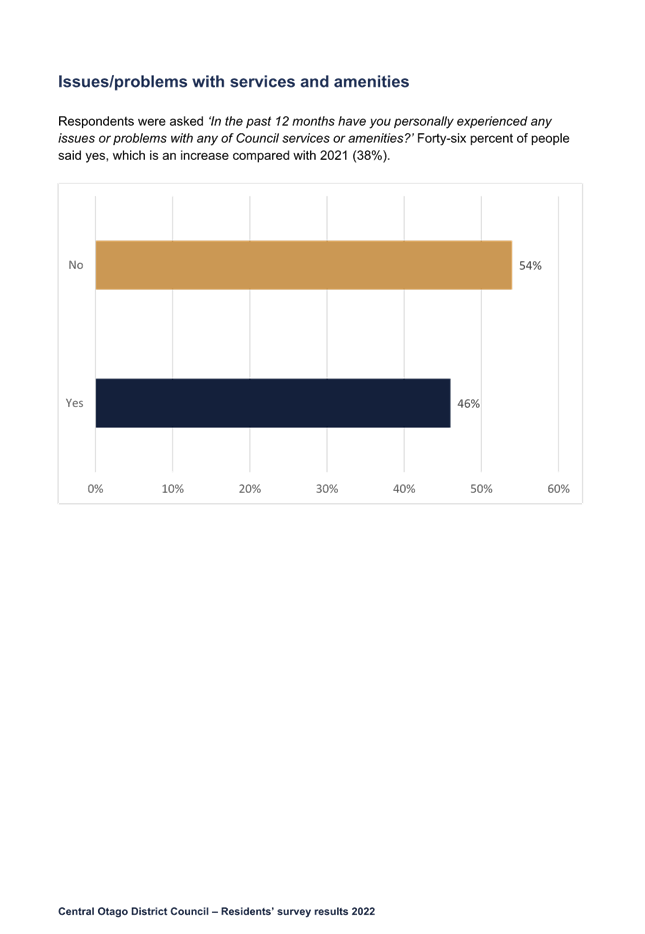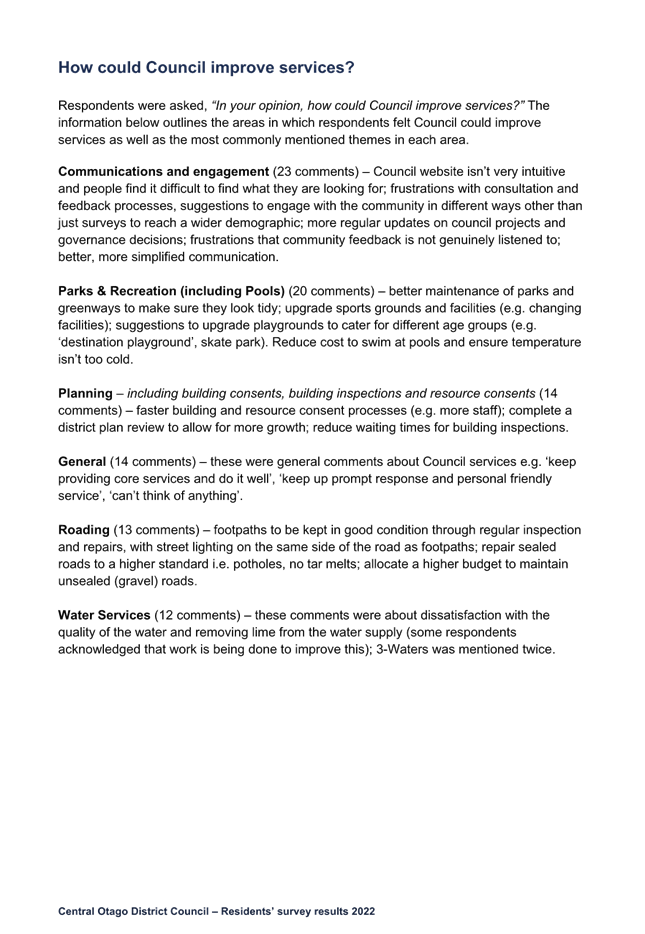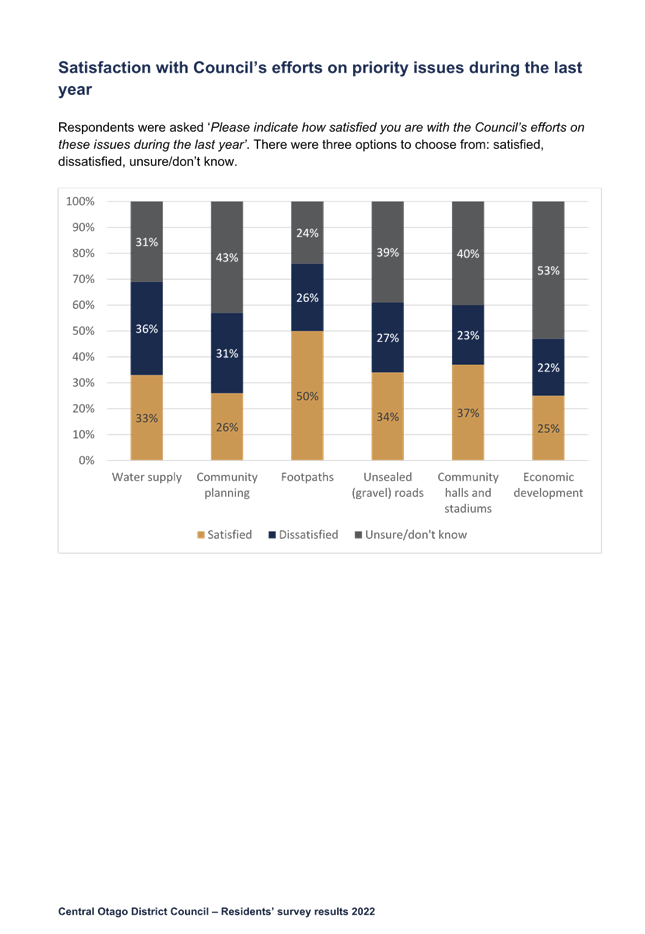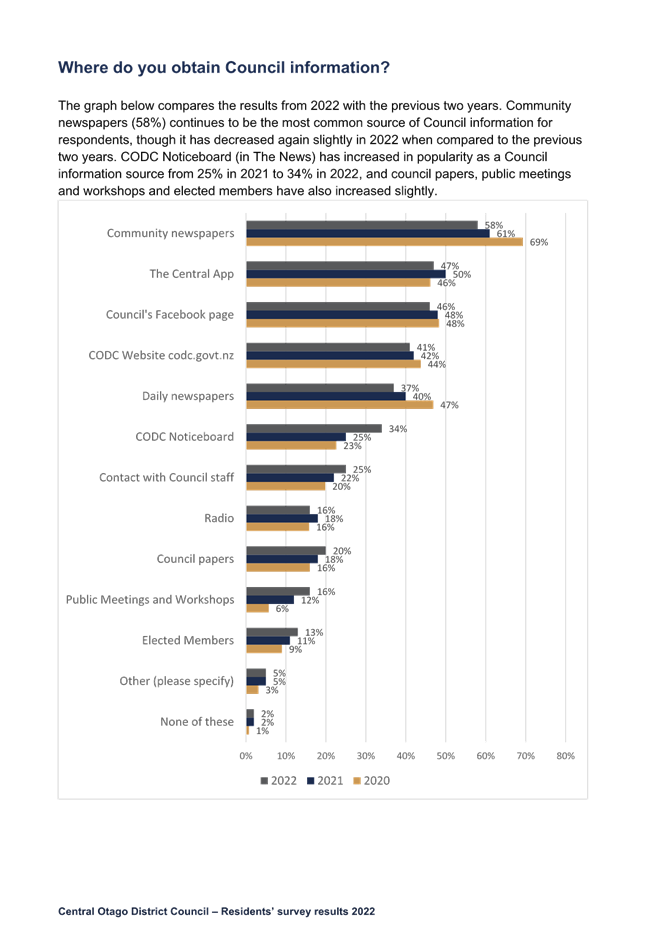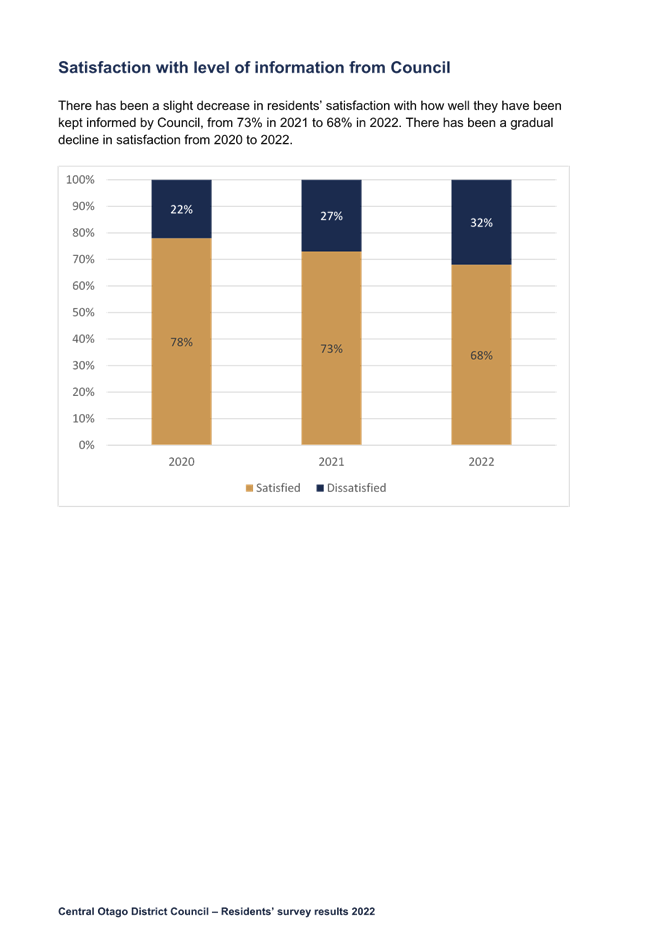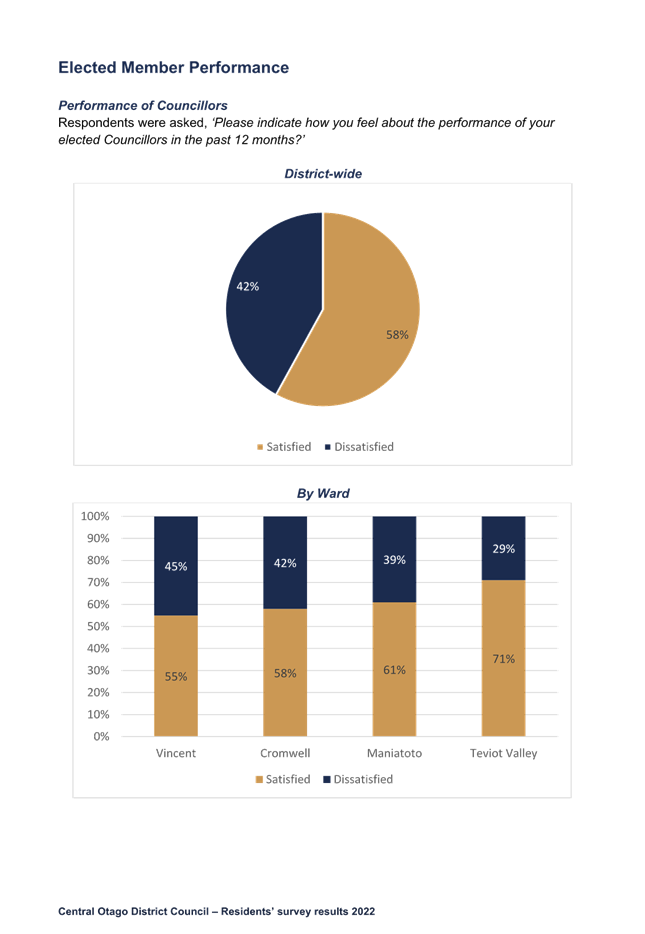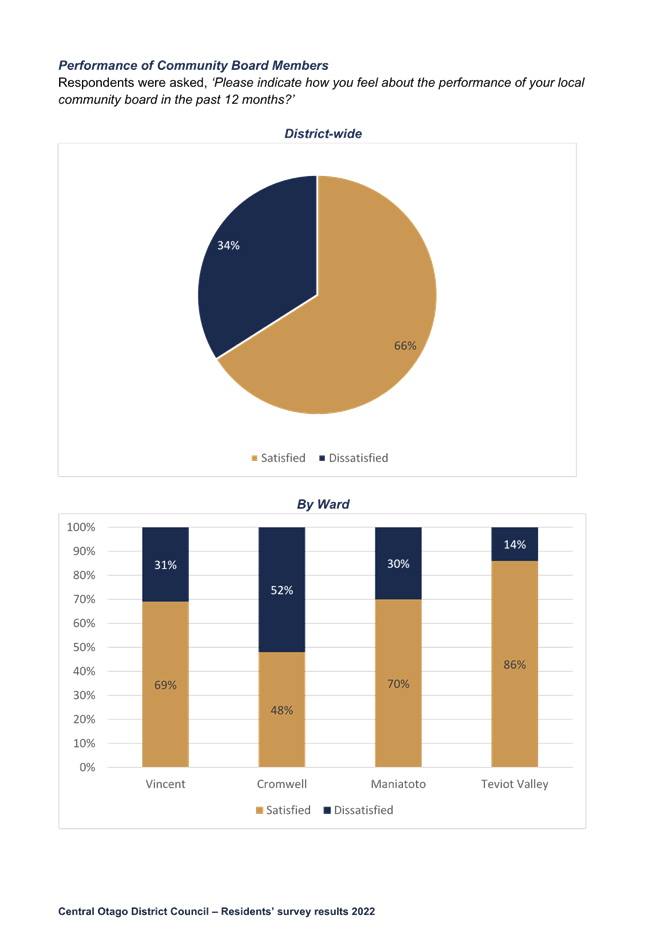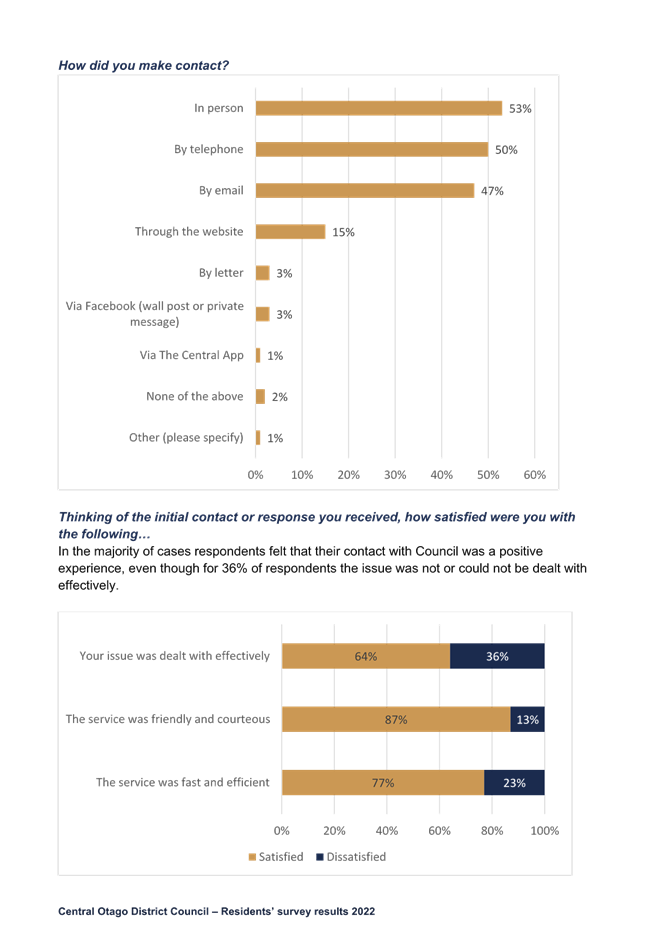|

|
|
AGENDA
Ordinary Council
Meeting
Wednesday, 9 November 2022
|
|
Date:
|
Wednesday, 9 November
2022
|
|
Time:
|
10.30 am
|
|
Location:
|
Ngā Hau e Whā, William Fraser Building,
1 Dunorling Street, Alexandra
(A link to the
live stream will be available on the Central Otago District Council's
website.)
|
|
Sanchia Jacobs
Chief Executive Officer
|
Members His
Worship the Mayor T Cadogan (Chairperson), Cr N Gillespie, Cr T Alley, Cr S Browne,
Cr L Claridge, Cr I Cooney, Cr S Duncan, Cr S Feinerman, Cr C Laws,
Cr N McKinlay, Cr M McPherson, Cr T Paterson
In Attendence S Jacobs (Chief
Executive Officer), J Muir (Three Waters Director), Q Penniall (Infrastructure
Manager), S Righarts (Group Manager - Business Support), L van der
Voort (Executive Manager - Planning and Environment), M De Cort (Communications
Coordinator), W McEnteer (Governance Manager)
1 Apologies
2 Public
Forum
3 Confirmation
of Minutes
Ordinary Council Meeting - 26
October 2022
|
Council Meeting Agenda
|
9 November 2022
|
MINUTES
OF A Council Meeting
OF THE Central Otago District
Council
HELD AT Ngā Hau e
Whā, William Fraser Building, 1 Dunorling Street, Alexandra
AND LIVE STREAMED VIA MICROSOFT TEAMS ON Wednesday, 26 October 2022 COMMENCING AT
2.00 pm
PRESENT: His
Worship the Mayor T Cadogan (Chairperson), Cr N Gillespie, Cr T Alley, Cr S
Browne, Cr L Claridge, Cr I Cooney, Cr S Duncan, Cr S Feinerman,
Cr C Laws, Cr N McKinlay, Cr M McPherson, Cr T Paterson
IN ATTENDANCE: S Jacobs (Chief Executive
Officer), L Fleck (General Manager – People and Culture), D Rushbrook
(General Manager, Tourism Central Otago), M Tohill (Communications Support) and
W McEnteer (Governance Manager)
Note: The Chief Executive Officer assumed to Chair to
begin the meeting.
1 Apologies
There were no apologies.
Note: Cr Browne joined the meeting at 2.03 pm.
The Chief Executive Officer welcomed councillors to the
meeting.
5 Reports
|
22.8.1 Declaration
of Office
|
|
The Chief Executive Officer
spoke of the meaning of the mayoral office and then His Worship the Mayor
made his declaration. Each member then made their declaration of office.
Following making his
declaration, His Worship the Mayor assumed the Chair.
|
|
22.8.2 Statutory
Advice and Code of Conduct
|
|
To
provide Council with advice concerning legislation relevant to the role of
members and to adopt a Code of Conduct.
|
|
Resolution
Moved: Feinerman
Seconded: Browne
That the Council
A. Receives
the report and accepts the level of significance.
B. Notes
the advice given on relevant legislation.
C. Adopts the Code of
Conduct.
Carried
|
|
22.8.3 Adoption
of Standing Orders
|
|
For
Council to adopt a revised version of Standing Orders.
|
|
Resolution
Moved: Alley
Seconded: Paterson
That the Council
A. Receives
the report and accepts the level of significance.
B. Adopts the revised Local
Government New Zealand Standing Orders with the following amendments:
i. Enable
provisions for meetings by audio visual link
ii. Enable
a casting vote for the chairperson
iii. Endorse
option C (informal) as the default for speaking and moving motions.
Carried
|
|
22.8.4 Appointment
of Deputy Mayor
|
|
To
inform the Council of the Mayor’s appointment of the Deputy Mayor.
|
|
Resolution
Moved: Duncan
Seconded: McKinlay
That the Council:
A. Receives
the report.
B. Notes the appointment
of Neil Gillespie as the Deputy Mayor.
Carried
|
|
22.8.5 Council
Organisations and Policy on Appointment of Directors
|
|
To
advise of the effect of appointing councillors to serve on its behalf on
outside organisations and to re-adopt the Policy on Appointment and
Remuneration of Directors to Council Controlled Organisations and Council
Organisations.
|
|
Resolution
Moved: Duncan
Seconded: McPherson
That the Council
A. Receives
the report and accepts the level of significance.
B. Re-adopts the Policy
on Appointment and Remuneration of Directors to Council Controlled
Organisations and Council Organisations.
C. Makes
appointments as recommended elsewhere in the agenda in light of the contents
of this report.
Carried
|
|
22.8.6 Adoption
of Interim Delegations Register
|
|
For
Council to adopt an interim Register of Delegations.
|
|
Resolution
Moved: Cadogan
Seconded: Alley
That the Council
A. Receives
the report and accepts the level of significance.
B. Adopts the interim
Delegations Register, to come into effect on 27 October 2022.
Carried
|
|
22.8.7 Appointment
of Councillors to Community Boards
|
|
To
advise Councillors that there is provision to appoint Councillors to be
members of Community Boards and to make decisions about those appointments.
|
|
Resolution
Moved: Cadogan
Seconded: Duncan
That the Council
A. Receives
the report and accepts the level of significance.
B. Appoints
Cr Duncan to the Maniototo Community Board.
C. Appoints
Cr Feinerman to the Teviot Valley Community Board.
D. Appoints
Crs Browne, Gillespie and Laws to the Cromwell Community Board.
E. Appoints
Crs Alley, McPherson and Paterson to the Vincent Community Board.
Carried
|
|
22.8.8 Council
and Committee Appointments
|
|
For
the Mayor to establish committees of the territorial authority and appoint
the chairperson of each committee established under Section 41A(3) of the
Local Government Act 2002.
|
|
Resolution
Moved: Cadogan
Seconded: Gillespie
A. Receives
the report and accepts the level of significance.
B. Notes
the reestablishment of the following committees and the Mayor’s
appointments to:
1. The
Audit and Risk Committee with the duties and powers as outlined in the
interim Delegations Register. Appoints His Worship the Mayor and Crs
Alley, Gillespie and Paterson to the Committee.
2. The
Executive Committee with the duties and powers as outlined in the interim
Delegations Register. Appoints His Worship the Mayor and Crs Alley, Duncan,
Feinerman and Gillespie to the Committee.
3. The
Assessment Committee with the duties and powers as outlined in the interim
Delegations Register. Appoints Cr Alley as the Chair and Cr Browne as the
Deputy Chair of the Committee.
4. The
Hearings Panel with the duties and powers as outlined in the interim
Delegations Register. Appoints Crs Cooney, Gillespie and McPherson to the
Panel.
C. Approves the
appointments to the following external committees:
1. Otago
Regional Transport Committee – Cr Duncan
2. Central
Otago Health Incorporated – Cr Paterson
3. Clutha
District Council’s appointment as Council’s representative on the
Otago Museum Trust.
4. Central
Otago Wilding Conifer Control Group – Cr Alley
5. Maniototo
Curling International Inc – His Worship the Mayor
Carried
|
|
22.8.9 Proposed
Meeting Schedule for the Remainder of 2022 and 2023
|
|
To
approve a schedule of meetings for the remainder of 2022 and 2023.
|
|
Resolution
Moved: Cadogan
Seconded: Alley
That the Council
A. Receives
the report and accepts the level of significance.
B. Adopts the proposed
meeting schedule for the remainder of 2022 and 2023.
Carried
|
3 Date
of Next Meeting
The date of the next
scheduled meeting is 9 November 2022.
The Meeting closed at 2.37 pm.
4 Declaration
of Interest
22.9.1 Declarations
of Interest
Doc ID: 601908
1. Purpose
Members are reminded of the need to be vigilant to stand
aside from decision making when a conflict arises between their role as a
member and any private or other external interest they might have.
2. Attachments
Appendix 1 - Declarations of
Interest ⇩
|
Council
meeting
|
9 November
2022
|



5 Reports
22.9.2 Proposed
Plan Change 20 - Heritage
Doc ID: 596129
1. Purpose
of Report
To consider the public notification
of proposed Plan Change 19 in accordance with Clause 5 of the first Schedule to
the Resource Management Act 1991.
To consider the release
of the Heritage Design guidelines for public consultation.
|
Recommendations
That the Council
A. Receives
the report and accepts the level of significance.
B. Directs that Plan
Change 20 be notified in accordance with Clause 5 of the first Schedule to
the Resource Management Act 1991.
C. Approves the
release of the draft Heritage Guidelines for public consultation.
|
2. Background
Plan Change 20 is being
proposed at the same time as proposed Plan Change 19, as there is a degree of
overlap between the two plan changes. Specifically, PC19 seeks to make a
complete and comprehensive suite of changes to the way the District’s
residential areas are zoned and managed. This includes the introduction of a
new Medium Density Residential Zone which would allow for development at a
higher density than is currently experienced within the District, and which will
apply within parts of the existing Clyde Heritage Precinct. A copy of Plan
Change 20 is attached in Appendix 1.
As noted earlier, PC19
proposes to amend the approach taken to what is currently the Residential
Resource Area. While PC 19 does not alter the framework applying to built
development within heritage precincts under Section 11, it does amend the
framework for what is anticipated by the underlying residential zoning in any
precincts with such an underlying zoning. In particular, the changes to the
residential framework will allow for a higher density of development within the
proposed medium density residential zone that encompasses part of the Clyde
Heritage Precinct. Where other Heritage Precincts are currently
zoned ‘Residential Resource Area’, PC19 proposes to change this to
‘Low Density Residential’. The objective, policy and rule framework
for all existing residential areas will also be altered through PC19. PC19 also
includes provisions that refer to the Clyde Heritage Precinct and within the
Medium Density Residential Zone in Clyde, a lower height limit is also
proposed.
3. Discussion
Plan Change 20 (PC20)
relates to minor changes proposed to Section 11 (Heritage Precincts) of the
Plan, to better align the matters of discretion and information requirements
for resource consents required for built development in a heritage precinct.
The change is based upon additional information that the Council has received
about the values and characteristics of these precincts in the form of draft
Heritage Guidelines prepared for the Council and attached in Appendix 2.
The draft Heritage
Guidelines were developed for Council by Dr Glen Hazelton following an
extensive review of the history and character of each precinct. The
purpose of the guidelines is to assist in protecting the unique character of
each precinct and encouraging new development that is sympathetic to and
enhances these characteristics.
The guidelines sit
outside the District Plan and are to be read alongside the relevant objectives,
policies, and precinct rules.
Section 86B (3) of the
Resource Management Act 1991 provides for any rule in a proposed plan that
protect historic heritage to have immediate legal effect from the date of
public notification, accordingly the proposed changes to Plan Change 20 will
have immediate legal effect.
Hearings on Plan Change
20 are anticipated to be heard within the same timeframe as Plan Change 19.
4. Financial
Considerations
The development of and progress of Plan Change 20 is
subject to statutory processes and is funded from the existing District
Plan review budget.
5. Options
Option 1 –
(Recommended)
Approve notification of
Plan Change 20 in accordance with Clause 5 of the First Schedule to the
Resource Management Act 1991 and approve the release of the Heritage Guidelines
for public consultation.
Advantages:
· The
proposed change reflects the feedback received from the community through the
spatial plan and feedback received through the notification of Plan Change 19.
· The
development heritage guidelines will help maintain the special character of
heritage precincts.
Disadvantages:
· No
obvious disadvantages
Option 2
Not approve notification
of Plan Change 20 in accordance with Clause 5 of the First Schedule to the
Resource Management Act 1991 or the Heritage Guidelines for public
consultation.
Advantages:
· No
obvious advantages
Disadvantages:
·
Risk of inappropriate development occurring in heritage precincts that has
adverse effects on their special character.
· Community
dissatisfaction when inappropriate development occurs in heritage precincts.
6. Compliance
|
Local Government Act 2002 Purpose Provisions
|
This decision enables democratic local decision making and action
by, and on behalf of communities by the Central Otago District Council.
The Council has functions under the RMA to carry out these
functions. The plan change process under the Resource Management Act is
a democratic public process and requires an assessment of the social,
economic, environmental, and cultural well-being.
|
|
Decision consistent with other Council plans and policies? Such as
the District Plan, Economic Development Strategy etc.
|
Yes – the Central Otago
District Plan
The proposed
plan change makes amendments to the operative Central Otago District Plan
|
|
Considerations as to sustainability, the environment and climate
change impacts
|
The
plan change process does not impact on these matters and the merits of the
plan change are considered against the RMA framework.
|
|
Risks Analysis
|
There
are no risks associated with this request
|
|
Significance, Consultation and Engagement (internal and external)
|
The
plan change will be publicly notified in accordance with the First Schedule
to the RMA, which provides a right of submission and further submission.
|
7. Next
Steps
Finalise
section 32 and publicly notify Plan change 20.
8. Attachments
Appendix 1 - Plan Change 20.docx ⇩
Appendix 2 - Draft Heritage
Guidelines.pdf ⇩
|
Report
author:
|
Reviewed
and authorised by:
|
|

|

|
|
Ann
Rodgers
|
Louise
van der Voort
|
|
Principal
Policy Planner
|
Executive
Manager - Planning and Environment
|
|
26/10/2022
|
28/10/2022
|
|
Council
meeting
|
9
November 2022
|



|
Council meeting
|
9
November 2022
|






























































22.9.3 Roxburgh
Golf Club Lease - Rent Review
Doc ID: 596840
1. Purpose
of Report
To consider the Teviot
Valley Community Board's recommendation to set the rent payable under the lease
held by the Roxburgh Golf Club at a reduced rate due to exceptional
circumstances.
|
Recommendations
That the Council
A. Receives
the report and accepts the level of significance.
B. Declines the Teviot Valley Community Board’s
recommendation to set the rent payable under the lease held by the Roxburgh
Golf Club in accordance with the earlier version of the Council's Community
Leasing and Licensing Policy 2019, at $772 per annum plus GST.
C. Agrees to exercise the exceptional circumstances
clause of the Council’s Community Leasing and Licensing Policy 2021,
and set the rent payable under the lease held by the Roxburgh Golf Club for
the next five years commencing 1 July 2021 at $772 per annum plus GST.
|
2. Background
At their meeting on 16
June 2022, the Teviot Valley Community Board (the Board) considered a report
regarding the leases held by the Roxburgh Golf Club (the Club).
The report recommended
that the Club's rent be reviewed and the golf course lease be varied to include
an additional land area.
A copy of the report
dated 16 June 2002 is contained within Appendix 1.
At the public forum,
prior to consideration of the report representatives of the Club addressed the
Board on the matter. During their presentation, the representatives advised
that they believe the Club should not be charged any rental as:
- the course is in a
rural area,
- the costs associated
with controlling noxious weeds and rabbits are high, and,
- they have a small
volunteer base than other larger golf clubs.
The Board resolved to
leave the report on the table pending the completion of the review of the
Council's Community Leasing and Licensing Policy (the Policy).
At their meeting on 06
July 2022, the Council reviewed the Policy. At that time, the Policy had been
operating for about one year.
The purpose of the
review was to identify and address any issues or challenges arising during the
first year of applying the Policy.
The review identified
several areas of the Policy needing further consideration. These included:
1. The
definition of income (for the purpose of determining rent).
2. Some
wording changes (to clarify the definition of 'affiliation fees').
3. How
rent is charged to groups with no memberships, and,
4. The
simplification of the process for granting licences to adjacent landowners.
The report also noted
that there had been historical instances of decision-making that did not align
with some other Council policies, such as Reserve Management Plans.
The Council accepted the
recommendations outlined in the report and resolved to update the Policy
accordingly.
Updated Policy
The following is an
extract from the revised Policy as it relates to determination of fees and the
definition of income.
Community leases or
licences are offered at a concessional rate, set significantly below potential
market rent. Council is able to support community groups and achieve community
outcomes through this Policy. The concessional rate is charged to assist in
offsetting related property and other costs.
Annual rentals are
calculated at 2.5% of the tenant's income less any affiliation fees.
For the purposes of
this Policy, income is calculated from any income related to the use of the
facility. This includes subscription or membership fees, casual entry, green
fees, and other income derived from the use of the facility (such as room or
venue hire). It does not include member derived income, other than subscriptions.
Income is calculated
over the most recent 5 year period for which the group has filed financial
accounts. Where a group does not have 5 years of financial accounts, the rental
fee will be calculated as an average over the financial statements that are
available. This rental fee shall apply for the first 5 years of the lease or
licence or until a rent review is completed.
In exceptional
circumstances where there are ongoing or direct costs involved with the
property or lease, the tenants and Council may agree to an alternative method
of determining rent if it is considered that the standard method will produce
an unjust outcome.
Rent reviews occur
every 5 years. The same assessment criteria is applied, based on the most
recent 5 years of financial accounts. Rent reviews are authorised by the Chief
Executive Officer.
Income: Any income
derived by a community group or tenant through the use of a facility. This
includes:
· any
subscription income (money paid by permanent or casual members of a group on a
periodic basis to belong to the group),
· casual
memberships (including green fees, entry fees, charges by the group for use of
parts of a facility)
· and other types
of income derived from the use of the facility. Groups without members may
still derive an income from the use of the facility.
On 1 July 2022, the
Board considered the findings of the Council's review above and resolved under
22.5.3 to:
A. Receives
the report and accepts the level of significance.
B. Agrees
to recommend to Council:
1. That
for the five years commencing 01 July 2021, the rent payable under the lease
held by the Roxburgh Golf Club shall be assessed in accordance with the
(original version of) Council's 2019 Leasing and Licensing Policy, at $772 per
annum plus GST.
2. To
vary the lease by increasing the area by 0.3000 hectares to approximately
45.3000 hectares by including the land containing the car park.
C. Notes
that the Board encourages the Club to apply for a grant through the community
grants process.
A copy of the report
dated 1 July 2002 is attached as Appendix 1.
The increase of the
leased area doesn't require Council's ratification, as the lease to the Club is
considered under the 2014 Teviot Valley Reserve Management Plan.
However, the Board
resolved to set the rent at an amount that is less than what is provided for
under the revised police. Therefore, ratification is required by the Council.
3. Discussion
The Club’s leases
state the rent would be calculated annually at 2.5% of the gross revenue
received, excluding gross revenue form the operations of the lessee’s
ancillary liquor licence. However, to date no rent has been charged.
Applying the previous
policy results in a $772 rental per annum for the Club.
Applying the revised
policy results in a $994 per annum rental for the Club.
The difference is the
inclusion of entry fees from tournaments within this calculation as per the
revised definition of income.
Applying the Policy to
the Club is consistent with other golf clubs throughout the district. This has
been occurring as their rent reviews or lease renewals are come due.
However, because the
Board decided to leave the previous report recommending the $772 rental per
annum lie on the table while Council reviewed the Policy, this has led to an
increase in rental for the Club.
The Board, therefore,
resolved to recommend to Council that the following option within the revised
policy applied and the lessor amount of $772 per annum be implemented:
In exceptional
circumstances where there are ongoing or direct costs involved with the
property or lease, the tenants and Council may agree to an alternative method
of determining rent if it is considered that the standard method will produce
an unjust outcome.
As a matter of principle
staff cannot recommend adopting a previous policy. However, staff can recommend
exercising the right of the exception circumstances clause within the revised
policy.
Therefore, the
recommendation of this report will be to decline the Teviot Valley Community
Board’s recommendation together with the recommendation to exercise the
right of exception circumstances clause within the revised policy.
4. Financial
Considerations
The rental will be paid to the Roxburgh Reserves
account.
The Club is also responsible for all outgoings
associated with the leasing of the land, including rates.
5. Options
Option 1 –
(Recommended)
Approve that due to
exception circumstances the rent payable under the lease held by the Roxburgh
Golf Club for the five-year period commencing 01 July 2021 shall be assessed at
a reduced rental of $772 per annum plus GST.
Advantages:
· Does
not disadvantage the Club because the Board decided to wait for the Council's
review of the Policy.
Disadvantages:
· None.
Option 2
To not approve the
reduction in rent.
Therefore, the rental for the next five years commencing 01 July 2021, the rent
payable under the lease held by the Roxburgh Golf Club shall be assessed at
$994 per annum plus GST. This is calculated by applying the Council's 2022
Leasing and Licensing Policy.
Advantages:
· Is
consistent with the revised policy.
Disadvantages:
· Does
not recognise the resulting increase in the rental amount for the Club because
of the Board's decision to wait for the Council to revise the Policy.
6. Compliance
|
Local Government Act 2002 Purpose Provisions
|
This decision enables democratic local decision making and action
by, and on behalf of communities by determining the terms and conditions on
which a sports club will occupy a part of the Roxburgh Recreation Reserve.
|
|
Decision consistent with other Council plans and policies? Such as
the District Plan, Economic Development Strategy etc.
|
The recommendation is consistent with the Community Leasing and
Licencing Policy and the 2014 Teviot Valley Ward Reserve Management
Plan.
|
|
Considerations as to sustainability, the environment and climate
change impacts
|
There is no sustainability, environmental, or climate impacts
associated with the recommendation.
|
|
Risks Analysis
|
There are no risks to Council associated with the recommendation.
|
|
Significance, Consultation and Engagement (internal and external)
|
The Significance and Engagement Policy has been considered with
none of the criteria being met or exceeded.
|
7. Next
Steps
1. The
Club is notified of the Council's decision.
2. Deed
of Variation of Lease drafted, then executed.
8. Attachments
Appendix 1 - Report to the Teviot
Valley Community Board, 9 September 2022 ⇩
|
Report
author:
|
Reviewed
and authorised by:
|
|

|

|
|
Christina
Martin
|
Louise
van der Voort
|
|
Property
and Facilities Officer (Vincent and Teviot Valley)
|
Executive
Manager - Planning and Environment
|
|
18/10/2022
|
28/10/2022
|
|
Council
meeting
|
9
November 2022
|

















22.9.4 Bannockburn
Domain Reserve Management Plan 2022
Doc ID: 595987
1. Purpose of Report
To adopt the Bannockburn Domain Reserve Management Plan
2022.
|
Recommendations
That the Council
A. Receives
the report and accepts the level of significance.
B. Recommends
that the Bannockburn Domain Reserve Management Plan 2022 is adopted.
|
2. Background
The Central Otago District Council is the
administering body for Bannockburn Domain
in terms of Section 40 of the Reserves Act 1977 (the Act). The
responsibility for administering and managing reserves including Bannockburn
Domain has been delegated to the Cromwell Community Board, with Council having
the power to adopt the final Reserve Management Plan under delegation from the
Minister of Conservation.
Section 41 of the Act describes
that all recreation reserves shall have a Reserve Management Plan prepared by
its administering body. The administering body of any reserve shall keep its
management plan under continuous review, so that the plan is adapted to
changing circumstances or in accordance with increased knowledge.
A Reserve Management Plan was
adopted in 2000. Since that time the reserve has been managed under a lease agreement
between Council and the Bannockburn Recreation Reserve Management Committee
Incorporated, (the Committee). The original lease expired in 2020 and has since
been renewed.
When the lease was renewed, it
was considered appropriate to prepare a new reserve management plan for the
following reasons:
· The existing plan was no longer reflective of the
current management situation.
· A new plan would provide for future development of the
reserve and reflect any pressures,
constraints, conflicts, and opportunities
resulting from growth experienced in the Bannockburn community since 2000.
· The age of the existing plan.
Additionally,
under Section 41 of the Act, every recreation reserve shall have an operative reserve
management plan. The purpose of a reserve management plan is to ensure that the
development and implementation of objectives and policies for a reserve
enhances the long-term use of the reserve without compromising its existing
use. A reserve management plan consists of both historical and current
information about the reserve, and a list of management statements to guide
consistent decision-making regarding the future development and management of the
reserve.
The
plan must be regularly reviewed as stated under Section 41 (4) of the Act "so
that the plan is adapted to changing circumstances or in accordance with
increased knowledge; and the Minister may from time to time require the
administering body to review its management plan, whether or not the plan
requires the approval of the Minister".
At its 7th September 2021 meeting the Cromwell Community Board
(the Board) resolved the following:
Receives the report and
accepts the level of significance.
Agrees to notify its intention to prepare a
Reserve Management Plan for the Bannockburn Recreation Reserve legally
described as Section 164 Block 1 Cromwell Survey District, S O Plan 19606
– 3.5365 hectares.
The draft plan was
prepared during the first half of 2022 and public submissions were sought over
a two-month period between May and July 2022. Additionally, all regular users
of Bannockburn Domain were sent documentation to enable them to make a
submission. Twenty-one submissions were received and considered by the Board at
its 12th September 2022 meeting.
At
its 12th September 2022 meeting the Board resolved the following.
Receives
the report and accepts the level of significance.
Resolves
that submissions be received.
Recommends
that the suggested amendments and changes to the draft plan are approved
by the Board.
Recommends to Council
adoption of the amended Bannockburn Domain Reserve Management Plan 2022.
Bannockburn
Domain comprises 3.5365 hectares and is legally described as Section
164 Block 1 Cromwell Survey District, Survey Office Plan 196060.
The
purpose of the Bannockburn Domain Reserve Management Plan is to provide Central
Otago District Council with an effective guide for managing the Bannockburn
Domain.
The
following table summarises Section 41 of the Reserves Act 1977 regarding
management plans, and the process used to develop this management plan. The
current step is highlighted in red.
|
Relevant Sections of
the Reserves Act
|
Public Consultation
|
Description of Activity
|
Phase
|
|
Section 41 (5)
Section 41 (5)c
Section 41 (6) a-c
Section 41 (6) d
Section 41 (6) d
|
Optional
Mandatory
|
Council notifies the public that it
is preparing a management plan and calls for submissions (one month)
ò
Public submissions are received and
incorporated into a draft management plan
ò
A draft management plan is made
available to the public for further comment (two months)
ò
The draft management plan is edited
to incorporate input from public submissions
ò
The final document is presented to
Council for adoption
|
Management Planning

|
|
Section 41
Section 41 (4)
|
|
All policies come into effect and
are enforceable by Council
ò
The management plan is continually
monitored and reviewed
|
Implementation
|
|
|
|
|
|
3. Discussion
A drop-in session was held at the Bannockburn Bowling Club on 14 June
2022. The public were invited to come along to discuss the Draft Bannockburn
Domain Reserve Management Plan and ask any questions of staff. Approximately 16
members of the public attended, and while much of the feedback could be used
for the proposed domain development plan, there were some key themes that
arose.
Overall, the attendees supported camping remaining on the domain, but
would like to see the layout of the campground amended to ensure that the sports field area is not used for camping and available
for year-round public use. Clearly delineating this space from the campground
was also suggested.
While there was consensus that the open space is an important asset, some
people do not feel welcome or comfortable with using the sports field area of the domain for public recreation,
due to the proximity of the campground.
Feedback provided indicated there is a lack of signage within the domain
to help deliver key messages, such as:
· dogs must be on a leash and are not permitted on the
playground or sports
field area.
· the area is smoke/vape free.
· the toilets, playground, tennis courts and sports field are available for public use.
Some submissions discussed the tennis courts, which people enjoy, but do
not use very much for several reasons:
· the backboard was taken away and never replaced
· the courts need resurfacing
· some people feel uncomfortable using the courts during peak
camping season
In addition to the drop-in session, twenty-one submissions were received
from the public notification process. The main themes were:
· Domain development
plan
A number
of ideas have come through in submissions that would contribute to improved
usage of the area (e.g., better signage, upgraded facilities, and changing the
campground layout).
These submissions will be considered as part of the domain
development plan. The development plan will be prepared after the reserve
management plan is adopted.
· Camping
Ground
Of the 21 submissions received, 15 mention the campground. In general,
submitters support the campground being on the domain, but there are requests
to ensure that the sports field area remain free from camping.
· The
submissions reflect a general concern that the campground may have people
living permanently on the domain, and additional space was required for storing
caravans all year round.
· There
are also some general questions around how the domain is managed. The Plan is
clear that the campground must operate within the Camping-Grounds Regulations
1985.Staff will work with the Committee to ensure regulations are complied with.
The development plan will clearly identify the parameters of
the camping ground area and sports field area. It is envisaged that the
addition of wayfinding signage will be installed to assist with this.
· Dogs
on the domain
Several submitters have raised concerns with dog control on the reserve
– this was also discussed at the drop-in session.
It is recommended that the Plan be amended to reflect the
CODC Dog Policy 2020, and that dog control signage be erected on the domain.
· Sports
field area
Many of the submissions suggest other ways that the sports field area at the
domain could be used and improved upon.
It is recommended that these ideas be taken into
consideration in the domain development plan.
· Other
o In
the Draft Plan, add to 5.1.2 Leases: Policy 5 - “If
a lease is cancelled either by Council or the lessee, Council will work to
secure another lessee in the first instance.”
o In
the Draft Plan - 5.9 Alcohol Licences: Amend - The Bannockburn Bowling Club
licence permits the sale of alcohol to members and guests of members.
The Bannockburn Reserve Management Committee Inc (the Committee) have
made a submission suggesting some amendments in the plan to clarify the
following points:
o that
the Bannockburn Reserve Management Committee Inc lease the entire reserve,
except the Bowling Club. Currently the draft plan specifies that the lease
is for the campground.
o Amend
name of the Committee to include “Management”
o Add
to 5.1.2 Leases:
§ Policy
1 add “1.1 The placement of any container on the reserve is
discouraged due to aesthetic appearance and clutter.”
§ Delete
Policy 2.1 –as sportsground area is currently leased by the committee.
However, given the feedback from the community on the importance of this sports field area, it is recommend negotiating with
the committee to remove this area from the lease.
o 5.2.1
Temporary Use & 5.2.2 Commercial Use to specify that requests will go
directly to the committee rather than Council for temporary use, and that
Council will liaise with the Committee if any requests come in for commercial
use.
o 5.5
Fireworks displays: Policy 1 - Delete “cricket wicket”
o 5.15
Vehicle Parking and Access: Policy 3 - Recommend “Regular overnight, residential
and long-term parking is not permitted outside of the campground.
Residential parking is not permitted anywhere on the domain.”
All agreed changes have
been highlighted in Appendix 1 - Final Bannockburn Domain Reserve
Management Plan 2022.
4. Options
Option 1 –
(Recommended)
To adopt
the Bannockburn Domain Reserve Management Plan 2022.
Advantages:
· Meets
statutory process as set out in the Reserves Act 1977.
· Considers
the input from community, including corrections and suggestions to the draft
plan and the management of the domain, provided by way of submissions.
· Provides
clear policy direction for future decision making regarding the domain.
· Provides
certainty for the community about the direction and operation of the domain.
Disadvantages:
· There are no
foreseeable disadvantages.
Option 2
Council does not adopt the Bannockburn Domain Reserve Management
Plan 2022.
Advantages:
· There are no
foreseeable advantages with this option.
Disadvantages:
· If
the Council do not adopt the plan, they may jeopardise their relationship with
the community.
· Considerable
time and resource have been spent on developing this reserve management plan.
5. Compliance
|
Local Government Act 2002 Purpose Provisions
|
This decision enables democratic local
decision making and action by, and on behalf of communities. The
preparation of this management plan
is a public process that will contribute to improved community outcomes and
enhanced community wellbeing through proactive planning for the future
utilisation of the Bannockburn Recreation Reserve.
|
|
Financial implications – Is this decision consistent with
proposed activities and budgets in long term plan/annual plan?
|
Cost for preparing this Reserve Management Plan will be accommodated
within existing budgets.
There is $8000 allocated for preparation of the Development Plan which
will be undertaken following the adoption of the Reserve Management Plan.
|
|
Decision consistent with other Council plans and policies? Such as
the District Plan, Economic Development Strategy etc.
|
This decision is
consistent with Councils plans and polices.
Central Otago District Council Long Term Plan 2021 – 31.
Bannockburn Recreation Reserve Management Plan 2000.
|
|
Considerations as to sustainability, the environment and climate
change impacts
|
A
well-planned and functional recreational area will contribute to ongoing
environmental sustainability.
|
|
Risks Analysis
|
Every recreation reserve shall have an operative management plan under
section 41 of the Reserves Act 1977.
|
|
Significance, Consultation and Engagement (internal and external)
|
The plan is not significant in terms of Council’s
Significance and Engagement Plan; however, the Reserves Act 1977 has its own
requirements for consultation which were followed in the preparation of this
plan.
|
6. Next Steps
· Council
adopts the Bannockburn Domain Reserve Management Plan 2022.
· The
adopted Bannockburn Domain Reserve Management Plan 2022 is forwarded to all
submitters with a formal response acknowledging their
submission.
· The Bannockburn Domain Reserve Management Plan 2022 is
uploaded to council’s website.
7. Attachments
Appendix 1 - Final Bannockburn
Recreation Reserve Management Plan 2022. ⇩
|
Report
author:
|
Reviewed
and authorised by:
|
|

|

|
|
Nikki
Aaron
|
Louise
van der Voort
|
|
Parks
Officer - Planning and Strategy
|
Executive
Manager - Planning and Environment
|
|
17/10/2022
|
17/10/2022
|
|
Council
meeting
|
9
November 2022
|









































22.9.5 Central
Otago District Council Tree Policy renewal
Doc ID: 596458
1. Purpose
of Report
To adopt the Central
Otago District Council Tree Policy 2022.
|
Recommendations
That the Council
A. Receives
the report and accepts the level of significance.
B. Adopts the
Central Otago District Council Tree Policy 2022.
|
2. Background
The Central Otago
District Council (Council) is responsible for approximately 6,500 trees in the
district, made up of approximately 3,000 street trees and 3,500 park or amenity
trees. Trees provide many benefits to a community, including aesthetic, environmental,
economic, cultural and social. Trees reinforce the local identity and character
of a place, which makes them an important tool in urban design, particularly
with increasing urbanisation.
Tree issues often
trigger an emotive response from the public for a range of reasons, from
excessive leaf dropping to shading. Good policy in this area is required to
ensure all tree requests are handled in an equitable manner.
The Central Otago
District Council Tree Policy 2020 had a renewal date of February 2022. The
policy has now been reviewed. The reviewed policy only contains minor
amendments including the addition of the Wilding Conifer Control Policy and the
proposed Open Spaces and Recreation Strategy. A 2025 date has been added for
the next review of this policy.
3. Discussion
The Central Otago
District Council District Tree Policy 2020 clearly sets out Council’s
position on planting, pruning, affected views, maintenance regimes and the
relationship with the Council’s District Plan heritage listed trees. It
also contains a suggested list of tree species to plant that provide seasonal
interest but do not pose problematic issues, including excessive root heave,
shading or growth into overhead utilities.
The suggested planting
guide is an indication only of trees that will generally perform well in
Central Otago and includes both natives and exotics. Seasonal displays from
trees particularly in spring and autumn sets Central Otago apart from other
areas of New Zealand. Natives also play an important part in the planting
fabric of the district, particularly for riparian and revegetation plantings.
The Policy also provides
guidance to developers for the provision of trees within new subdivisions from
guidance on minimum verge size, acceptable tree species and use of root guards.
The
differences between what the Policy covers and how trees are protected under
the District Plan is illustrated in the Policy to clearly show the different
levels of protection trees are afforded under the two different documents
A review of the Policy
has taken place with no major changes suggested. The Wilding Pines Control
Policy has been added to the Relevant Documents section of the policy and the
date has been amended to 2022-2025.
4. Financial
Considerations
There are no financial implications associated with
adopting this policy.
5. Options
Option 1 –
(Recommended)
Adopt the Central Otago
District Council Tree Policy 2022-2025.
Advantages:
· The
policy will continue to provide adequate direction to meet the changing needs
of the community regarding tree matters.
Disadvantages:
· No
disadvantages have been identified.
Option 2
Do not adopt the Central
Otago District Council Tree Policy 2022-2025.
Advantages:
· No
advantages have been identified.
Disadvantages:
· The
policy provides adequate direction to meet the changing needs of the community
regarding tree matters.
6. Compliance
|
Local Government Act 2002 Purpose Provisions
|
This decision promotes the social, cultural, and environmental wellbeing
of communities, in the present and for the future, by having well-managed public trees that add to the
environmental and cultural wellbeing of the district’s communities.
|
|
Decision consistent with other Council plans and policies? Such as
the District Plan, Economic Development Strategy etc.
|
This
is consistent with the previously adopted Central Otago District Council Tree
Policy 2020-2022.
|
|
Considerations as to sustainability, the environment and climate
change impacts
|
Trees
absorb carbon dioxide from the environment and provide cooling and shade,
contributing to mitigating the effects of climate change.
|
|
Risks Analysis
|
There
is considerable risk for Council in not proactively managing, maintaining and
inspecting its tree assets. This policy supports a proactive maintenance
regime based on a regular maintenance and inspection cycle.
|
|
Significance, Consultation and Engagement (internal and external)
|
A previous version of this policy was consulted on under the Significance
and Engagement Policy. As there are no major changes to this updated policy,
it is not considered necessary to consult on its contents again at this
stage.
|
7. Next
Steps
Once
endorsed by Council, the Central Otago District Council Tree Policy 2022 will
become operative and reviewed in three years.
8. Attachments
Appendix 1 - Tree Policy
2022-2025.docx ⇩
|
Report
author:
|
Reviewed
and authorised by:
|
|

|

|
|
Nikki
Aaron
|
Louise
van der Voort
|
|
Parks
Officer - Planning and Strategy
|
Executive
Manager - Planning and Environment
|
|
18/10/2022
|
25/10/2022
|
|
Council
meeting
|
9 November
2022
|



































22.9.6 Future
for Local Government Draft Report
Doc ID: 601421
1. Purpose
To consider an update on
the Future for Local Government review
|
Recommendations
That the report be received.
|
2. Discussion
The draft document has
recently been released as part of the Future for Local Government reform
programme. Submissions are open now and will close on 28 February 2023. Staff
will work with councillors to draft a submission. In addition, there is a
roadshow scheduled in Dunedin in December for elected members to engage with
the review panel.
Please see the draft
report in appendix 1.
3. Attachments
Appendix 1 - Future for Local
Government Draft Report ⇩
|
Report
author:
|
|

|
|
Sanchia
Jacobs
|
|
Chief Executive
Officer
|
|
1/11/2022
|
|
Council
meeting
|
9
November 2022
|





















































































































































































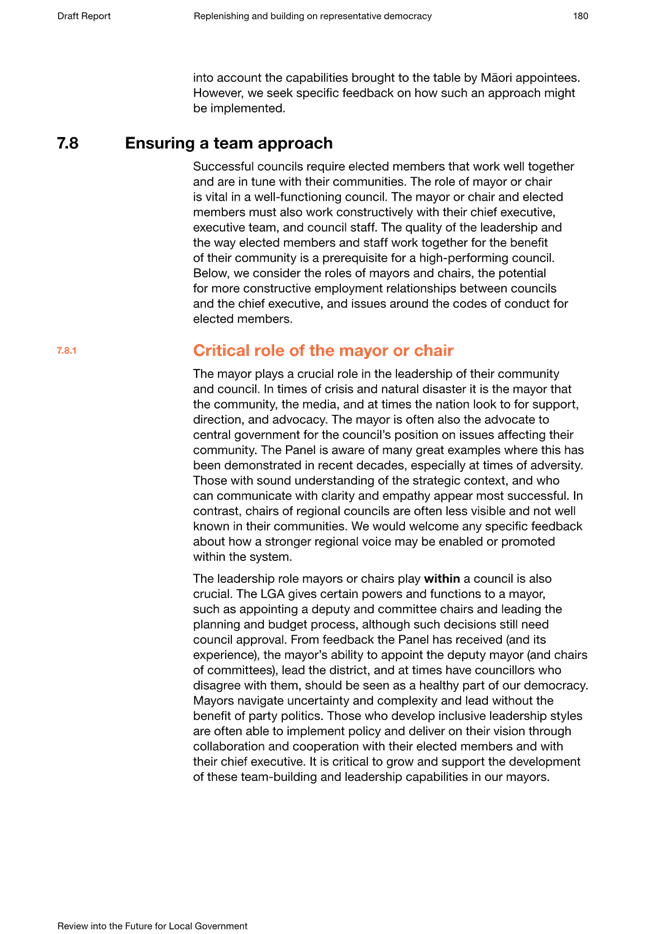


































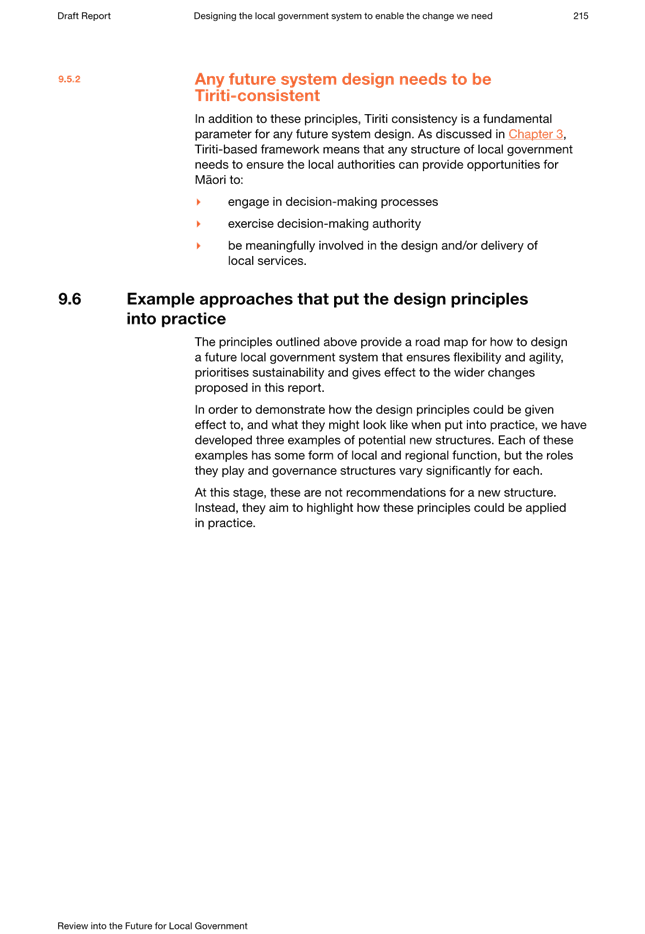


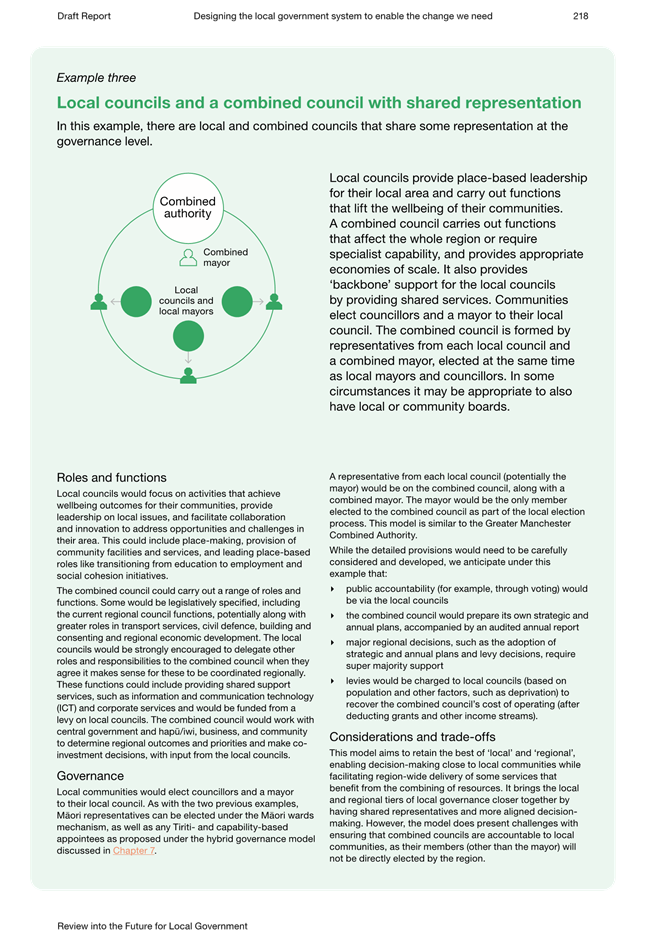
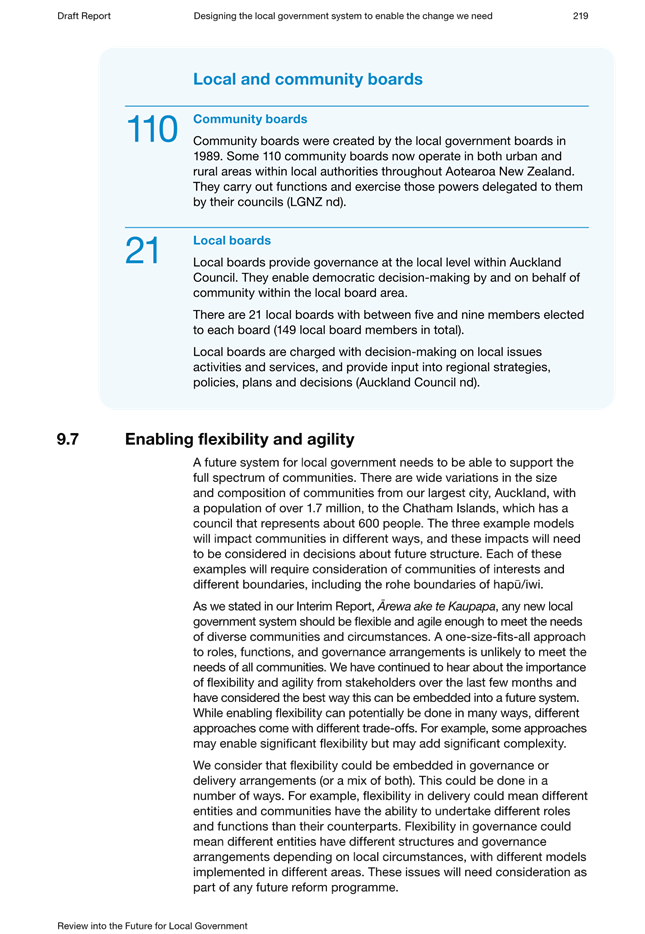








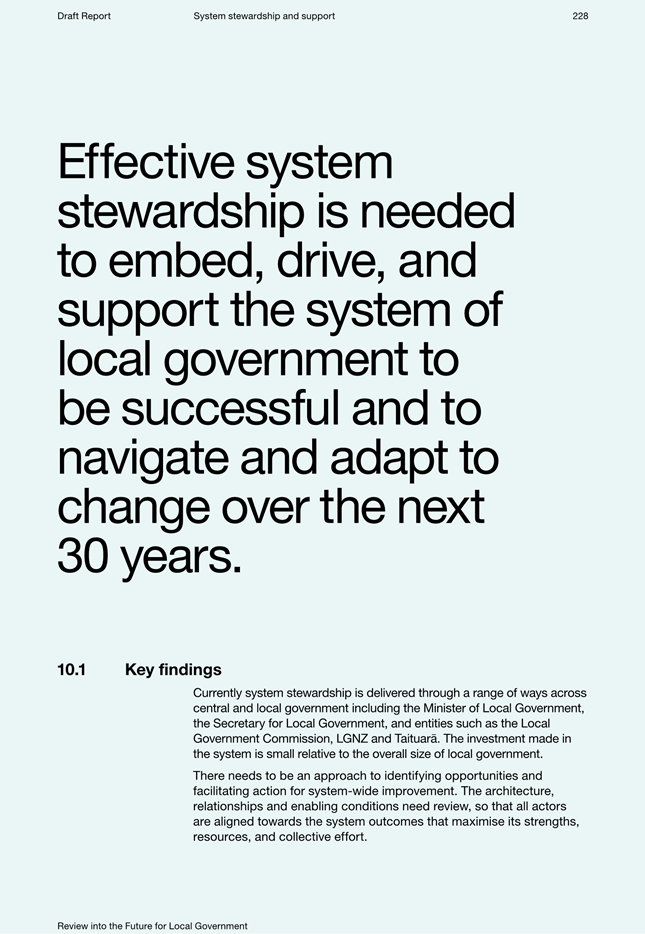


















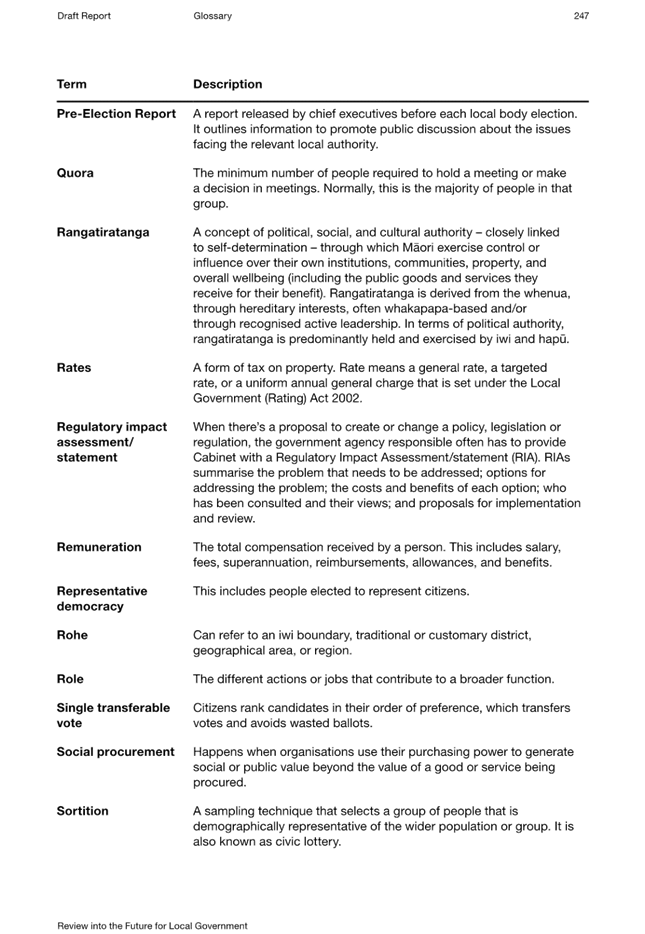




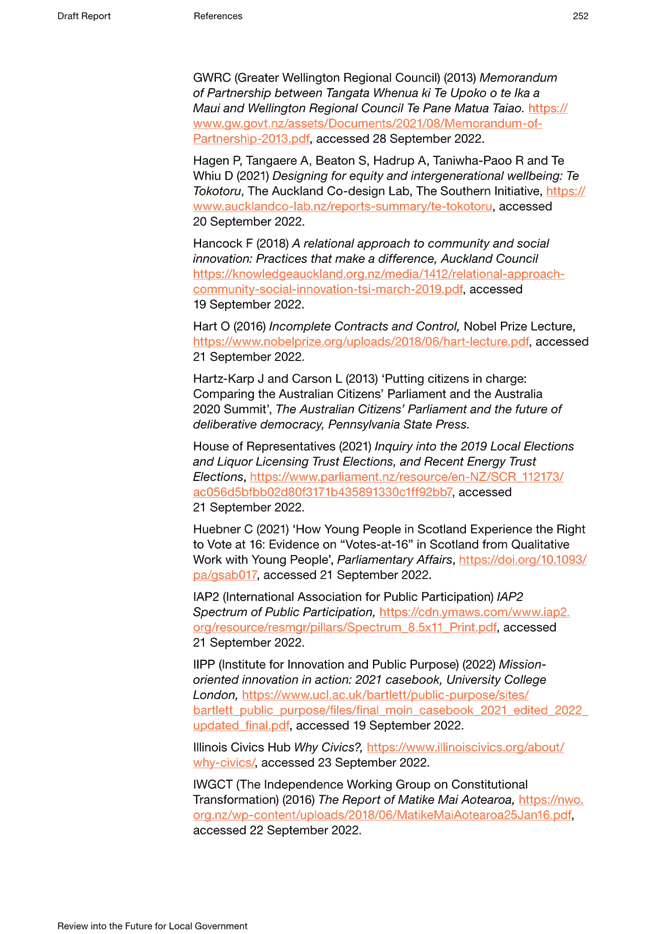



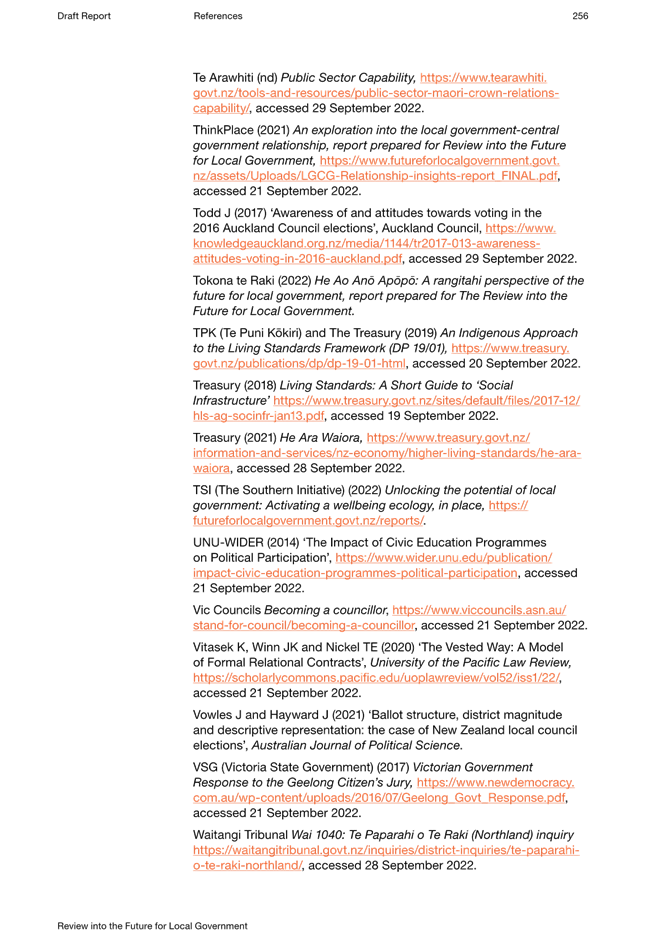
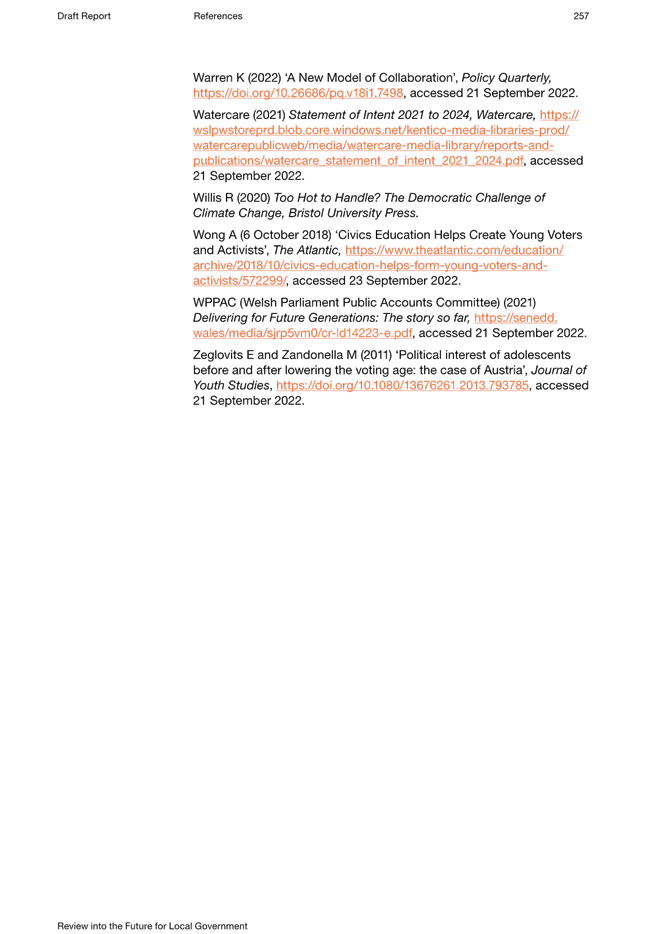


22.9.7 Register
of Delegations
Doc ID: 601041
1. Purpose
of Report
To adopt the updated
Register of Delegations, to come into effect on 21 November 2022.
|
Recommendations
That the Council
A. Receives
the report and accepts the level of significance.
B. Notes the
decisions made in the interim Register of Delegations.
C. Adopts the
updated Register of Delegations, to come into effect on 21 November 2022.
|
2. Background
At the 26 October
Council meeting, an interim Register of Delegations was adopted. At the
meeting, it was discussed that the interim register would confirm delegations
for the community boards and the establishment of council portfolios. However,
work continued on the delegations to the Chief Executive Officer.
3. Discussion
On the 21 November 2022
a new executive leadership team structure will come into effect. The new
structure changes the reporting lines of various functions within the
organisation, includes the establishment of one new executive role, and new job
titles across the Executive Leadership Team. Two staff will start ingroup
manager positions (Experience and Vision respectively), and the current
Executive Manager Planning and Environment position will change to Group
Manager Planning and Infrastructure. Two other executive positions have already
come into effect – Group Manager Business Support and General manager
People and Culture. A new fixed term position of Three Waters Director
was also created in July.
The Chief Executive
Officer has made temporary written delegations to ensure business continuity
during the transition of senior roles (as per her authority in the current
Registrar of Delegations). These delegations were noted at the last Audit and
Risk meeting on 27 September 2022.
Changes have been made
to the attached delegations register to reflect these changes (see track
changes in the attached document). The internal staff delegations manual has
been updated to reflect this new structure. This document has been reviewed by
the Chief Executive Officer.
In addition, at their
inaugural meeting the Maniototo Community Board appointed Cr Duncan to be a
liaison for the Maniototo Ice Rink. It was noted that His Worship was also
appointed as a liaison to the same group for the Council. It was suggested that
Cr Duncan could do both together and that the Register of Delegations be
changed to reflect this. His Worship is supportive of this proposal.
4. Financial
Considerations
There are no financial considerations to be made as
a result of this decision, beyond the monetary level of delegation approved.
5. Options
Option 1 –
(Recommended)
Adopt the updated
Register of Delegations to come into effect on 21 November 2022.
Advantages:
· Ensures
the delegations to the Chief Executive Officer and associated delegations she
can make are consistent with the organisational structure.
· Provides
clarity to staff on their levels of delegation.
Disadvantages:
· None
identified.
Option 2
Not adopt the updated
Register of Delegations.
Advantages:
· None
identified.
Disadvantages:
· Lack
of clarity on delegations to staff.
· Risk
of staff authorising financial transactions without authority.
6. Compliance
|
Local Government Act 2002 Purpose Provisions
|
This decision enables democratic local decision making and action
by clearly articulating where the delegations for decision lie.
|
|
Decision consistent with other Council plans and policies? Such as
the District Plan, Economic Development Strategy etc.
|
This
is a procedural decision and therefore has no impact on other plans and
policies and is not inconsistent with them.
|
|
Considerations as to sustainability, the environment and climate
change impacts
|
There
are no implications from this decision.
|
|
Risks Analysis
|
There
are no inherent risks with the recommended option.
|
|
Significance, Consultation and Engagement (internal and external)
|
This
is a procedural matter and, therefore, no external consultation or engagement
is required.
|
7. Next
Steps
Once adopted, the
Register of Delegations will come into effect on 21 November 2022 and will be
published on the Central Otago District Council’s website. Until then the
interim register will be in force.
8. Attachments
Appendix 1 - Updated Register of
Delegations ⇩
|
Report
author:
|
Reviewed
and authorised by:
|
|

|

|
|
Saskia
Righarts
|
Sanchia
Jacobs
|
|
Group
Manager - Business Support
|
Chief
Executive Officer
|
|
28/10/2022
|
28/10/2022
|
|
Council
meeting
|
9
November 2022
|


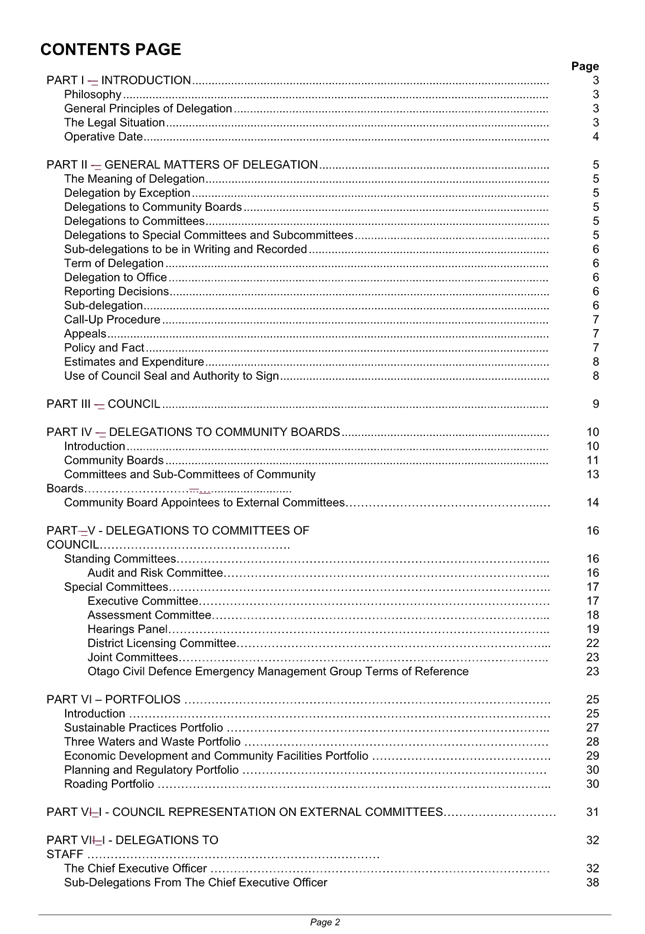









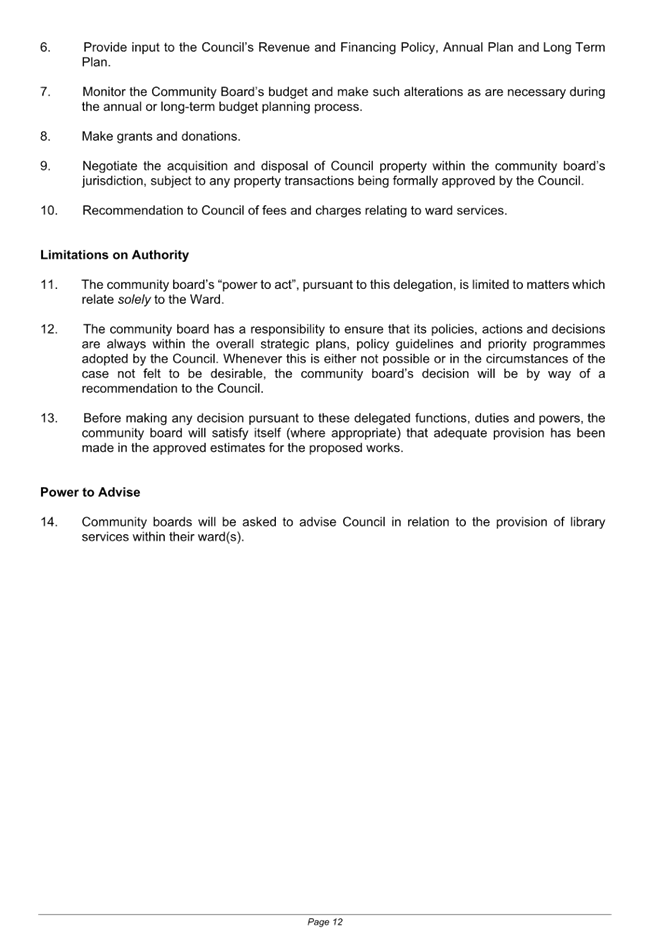
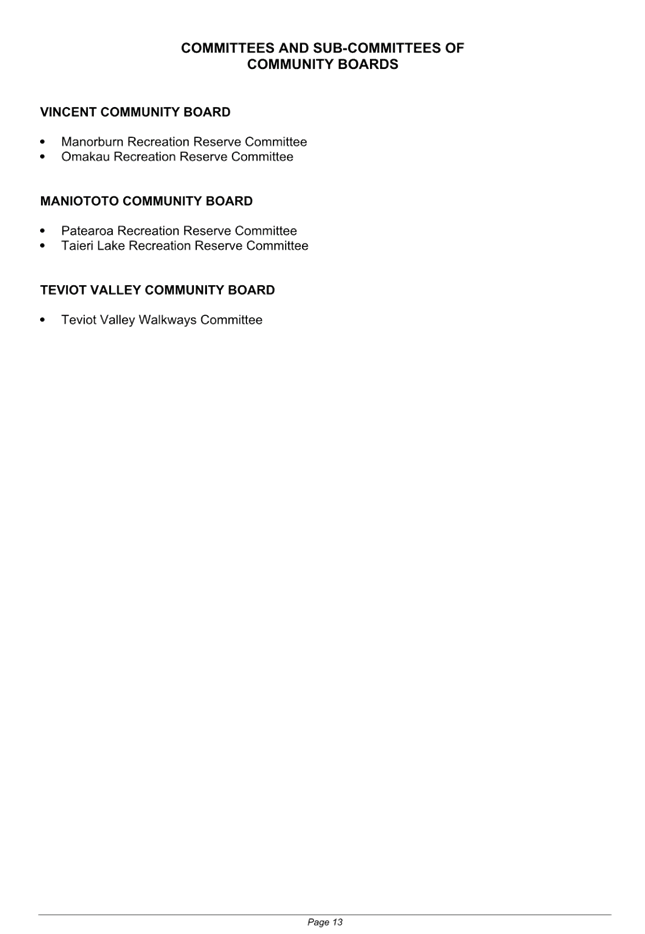

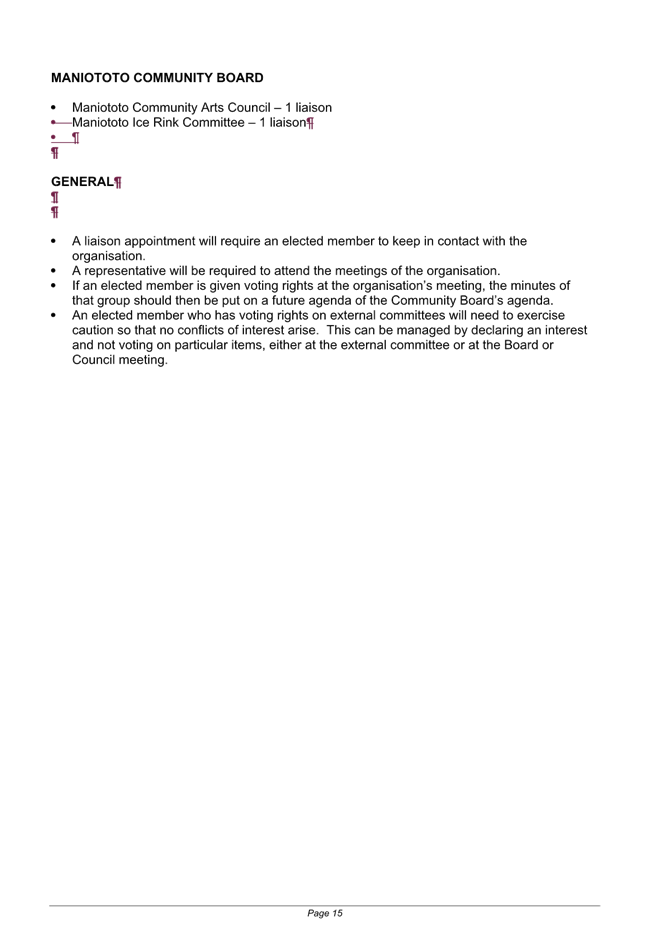


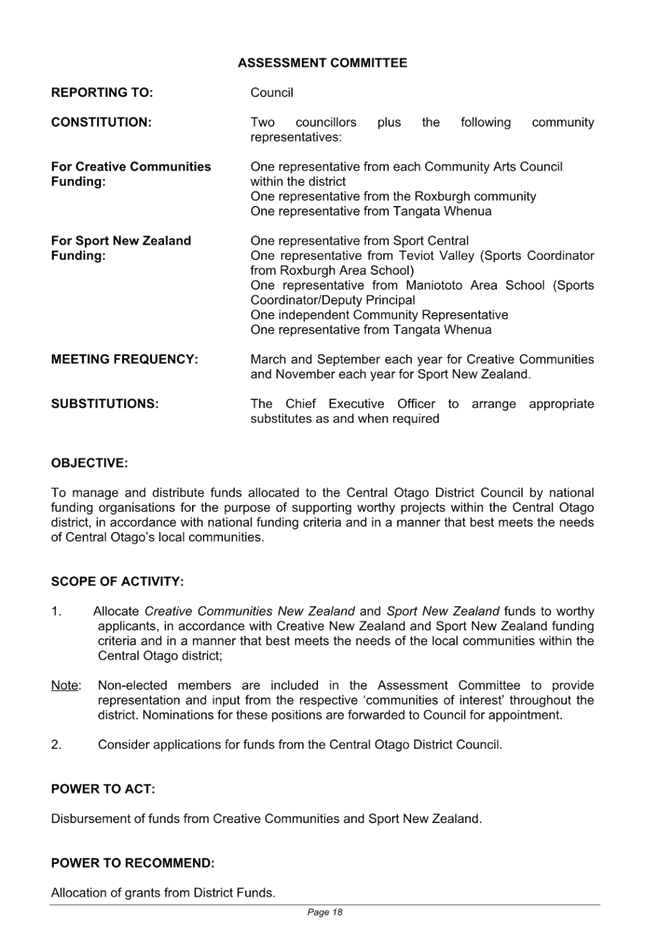



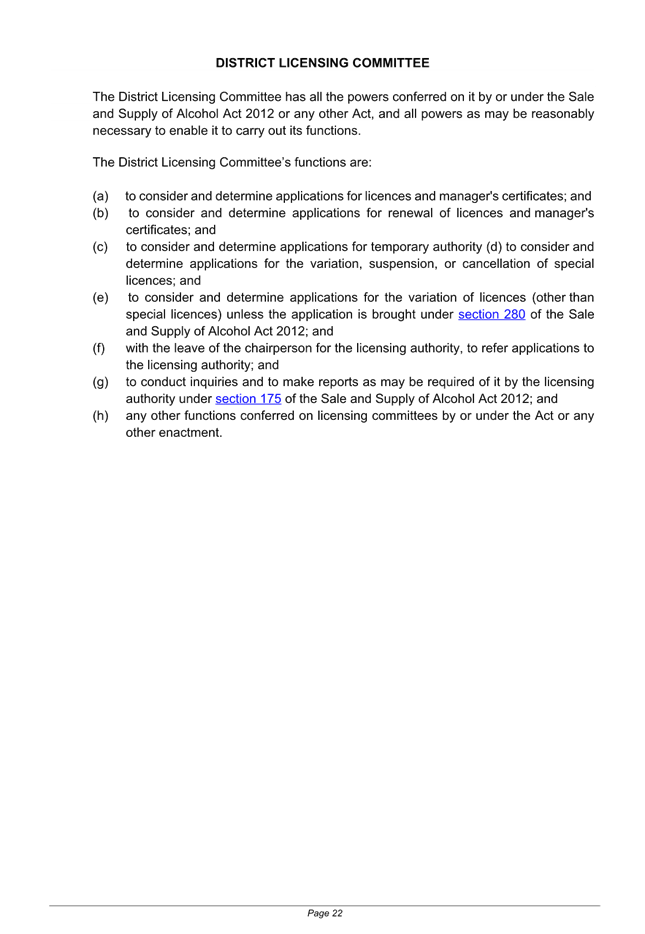
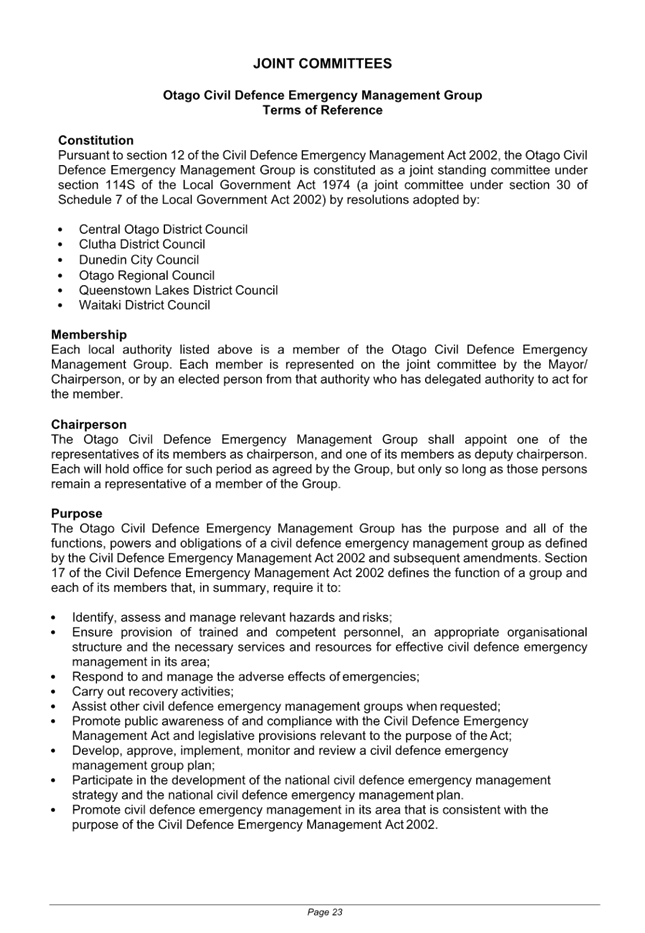
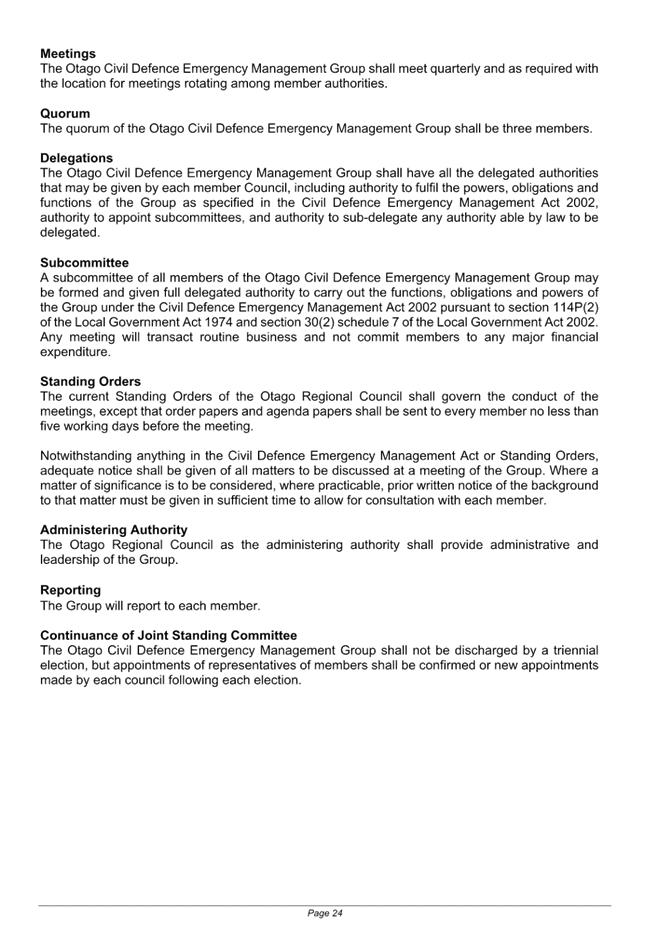
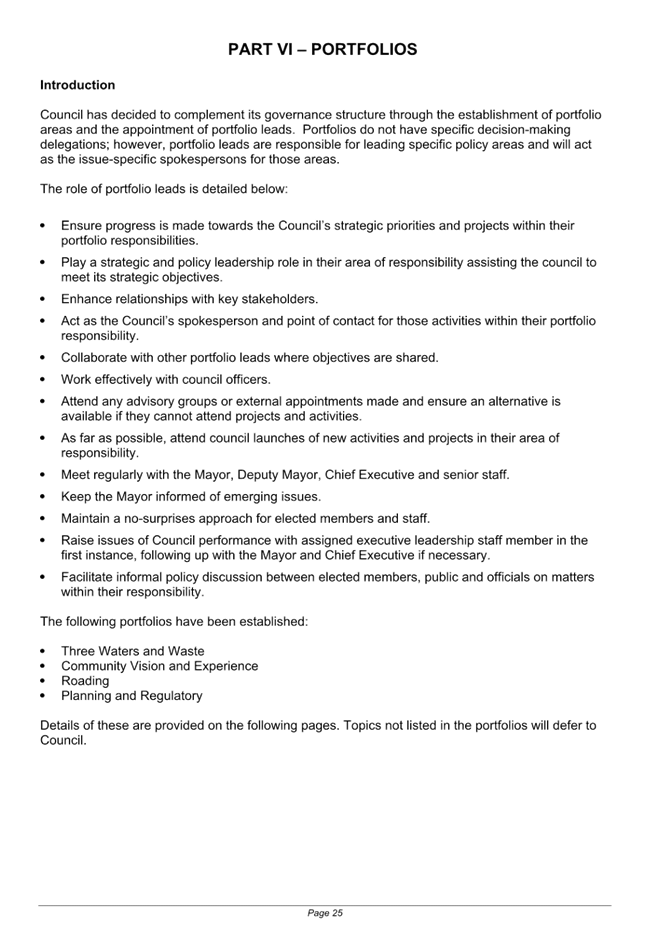
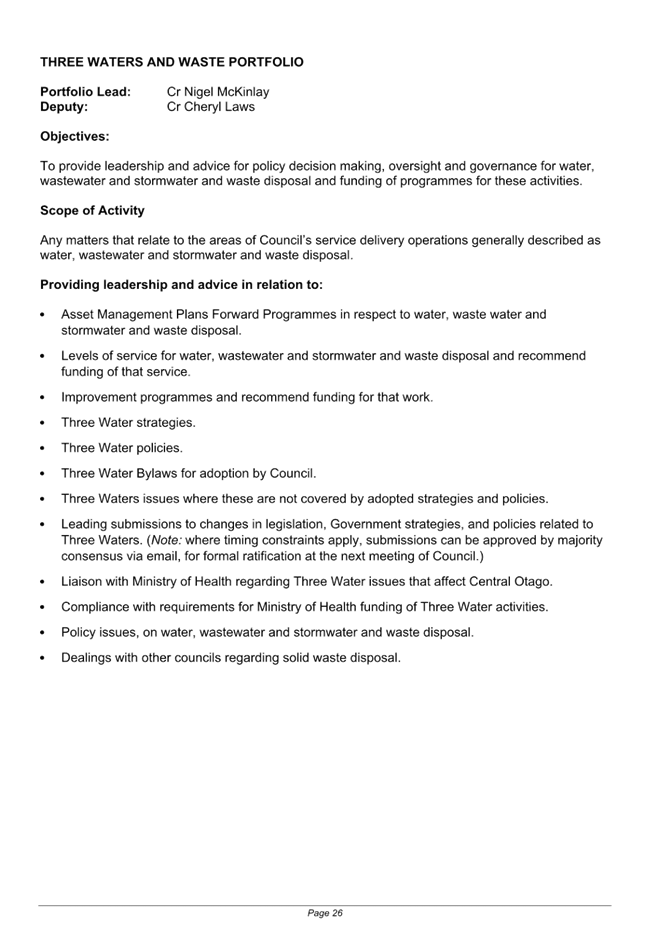
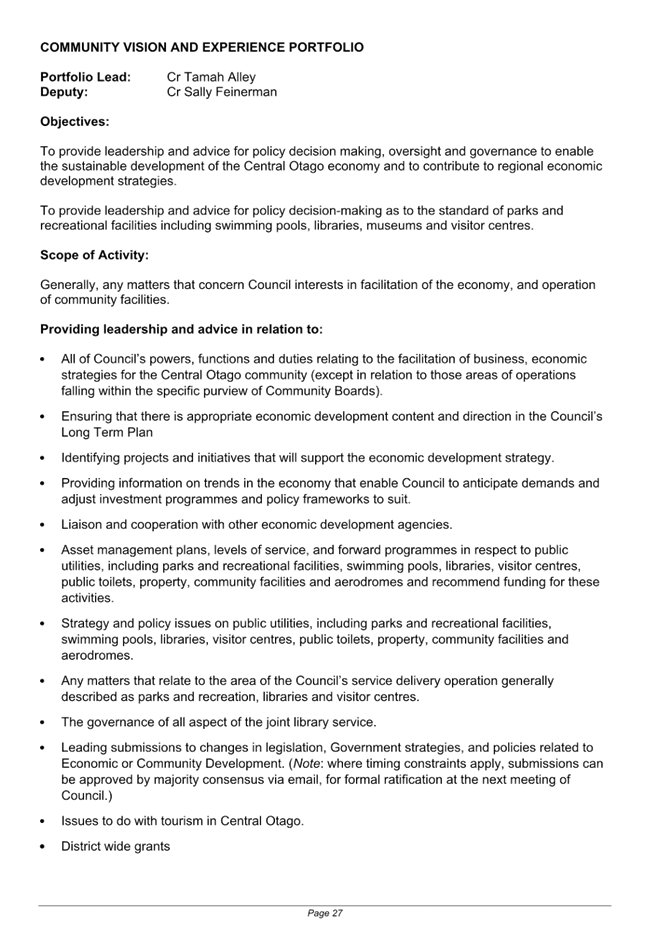
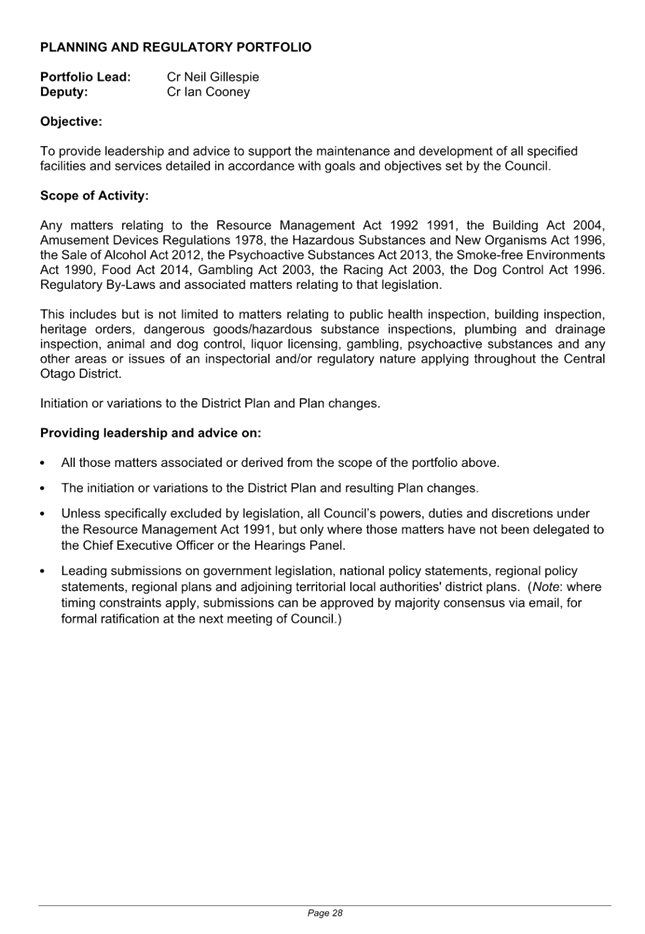

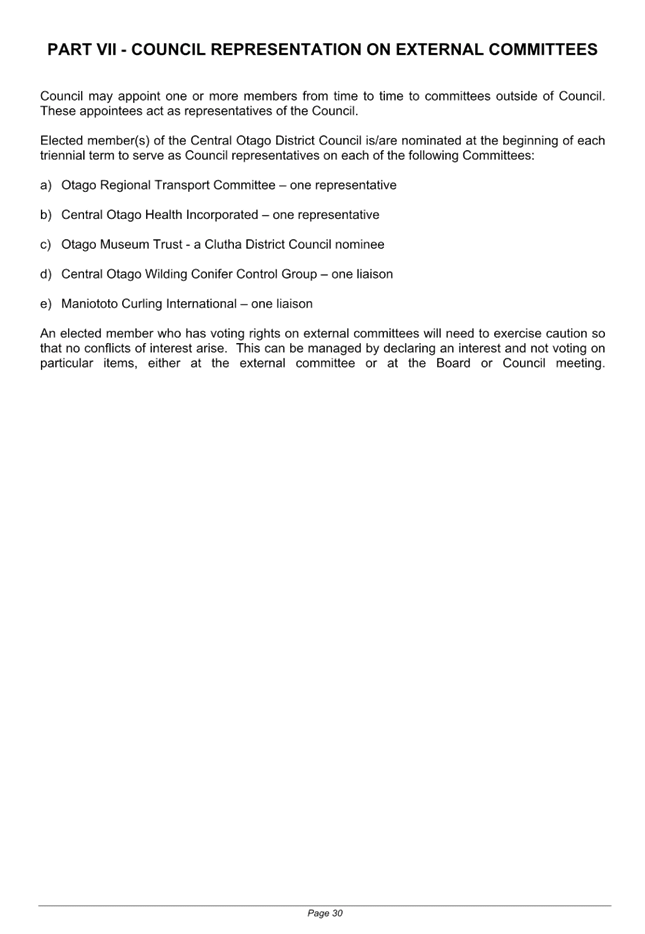

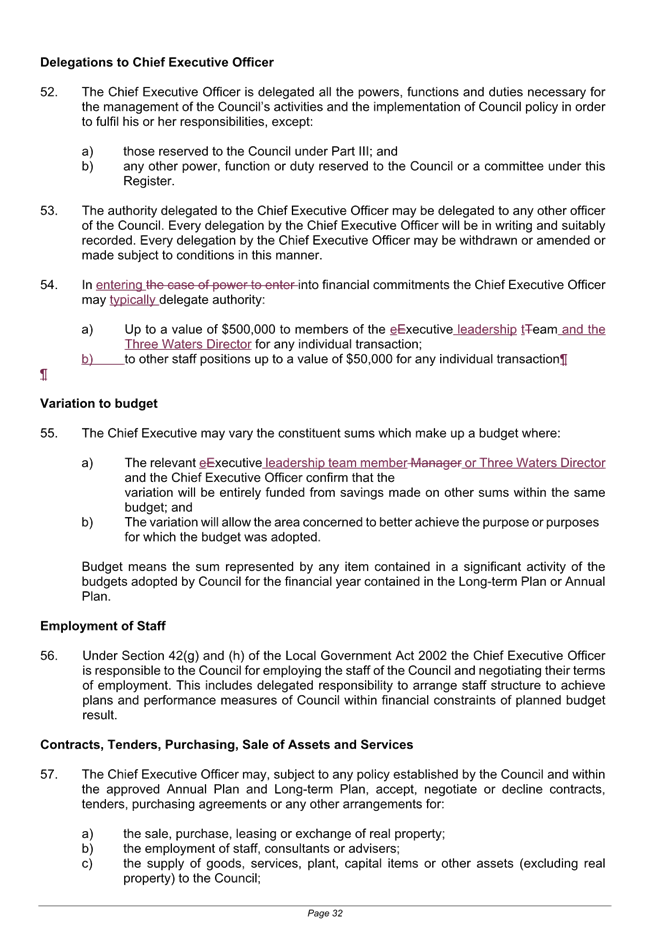


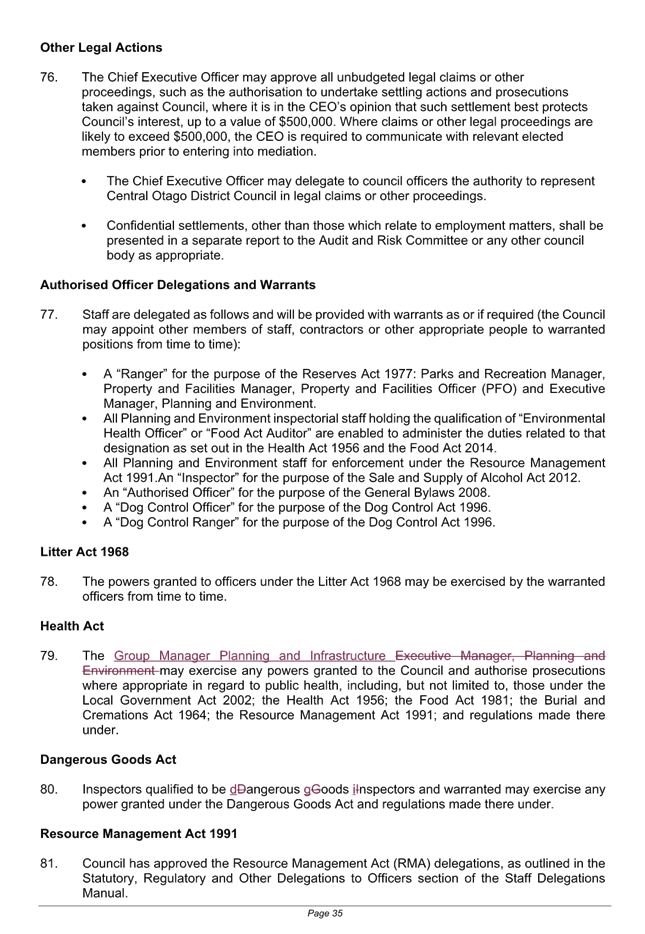
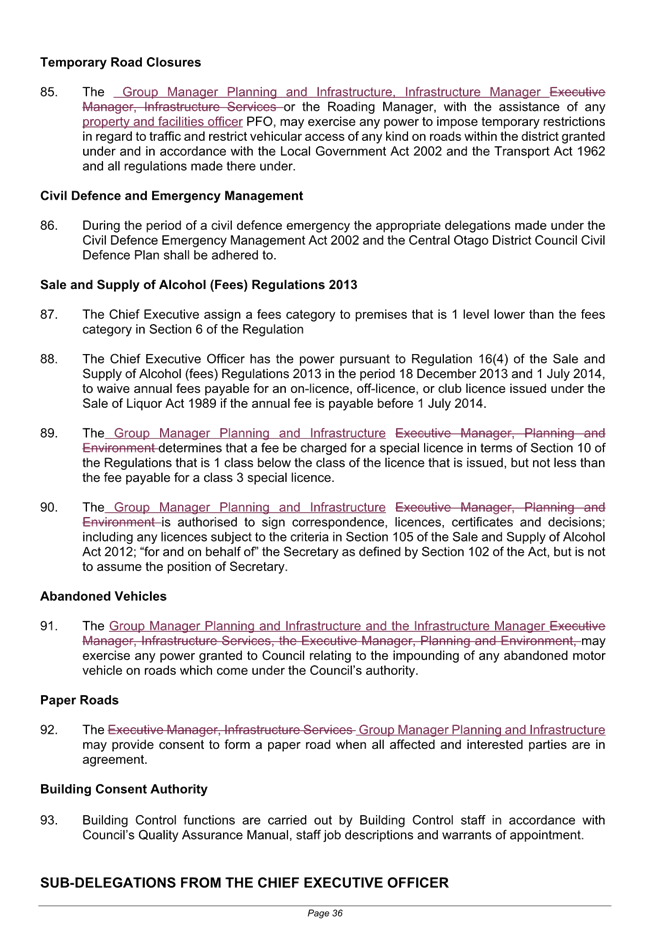

22.9.8 Development
of the 2024-34 Long-term Plan
Doc ID: 600935
1. Purpose
of Report
To consider the draft
timeline for the development of the 2024-34 Long-term Plan.
|
Recommendations
That the Council
A. Receives
the report and accepts the level of significance.
B. Approves the draft timeline.
|
2. Background
Under the Local
Government Act 2002, every council in New Zealand must develop and adopt a
long-term plan every three years. The long-term plan is the key strategic
planning document for council as it sets the 10-year direction and articulates
what will be delivered to the community and why, and how this will be funded.
The next long-term plan must be adopted by 30 June 2024.
3. Discussion
The development of a
long-term plan is a significant piece of work that requires involvement from
the community and elected members. Elected members will set the strategy for
the next ten years and well as consider how best to deliver to this strategy.
This will involve consideration of economic, cultural, social and environmental
factors (the four well-beings) to best deliver to the communities in Central
Otago.
As the plan evolves,
projects and activity to deliver to the aspiration of elected members (on
behalf of the community) will be articulated and costed. Two significant
strategies will also be developed (infrastructure and financial strategies)
that describe how Council will plan ahead and be prudent with the finances to
ensure ratepayers are getting value for money. This involves striking a fine
balance between aspirations of the community and ensuring also that rates are
set at a reasonable level.
Attached is the draft
timeline with the key milestones to achieve the development of the 2024-34
Long-term Plan. Currently the Plan has been developed to be completed by May
2024, which enables some flexibility on the final due date in particular with
the audit processes which are largely outside of Council’s control. Audit
New Zealand are having significant resourcing challenges (currently impacting
on the audit timeframes for the 2021/22 Annual Report) so it is likely that the
attached draft timeline will change as the scheduling of the audit becomes
clearer.
Also, dependant on the
direction from elected members next year it may also be that additional
workshops and/or papers need to be scheduled to explore projects and options.
More detail will be
provided as the Plan progresses, but to note the Plan development will commence
at Council’s next meeting in December 2022 where elected members will
consider the development of a district vision and accompanying community
outcomes. The next significant step will be at the January 2023 meeting, where
elected members will discuss their aspiration and what they wish to achieve for
the community in this long-term plan.
4. Financial
Considerations
There are no direct financial implications as a
consequence of this decision.
5. Options
Option 1 –
(Recommended)
Approve the draft
timeline for the development of the 2024-34 Long-term Plan.
Advantages:
· Provides
visibility on the milestones needed to be achieved as the Plan develops
· Facilitates
planning and scheduling of papers and workshops in advance with elected members
· Provides
a mechanism for accountability and adherence to deadlines as the Plan evolves.
Disadvantages:
· None
identified.
Option 2
Do not approve the draft
timeline for the development of the 2024-34 Long-term Plan.
Advantages:
· None
identified.
Disadvantages:
· There
will be no clear and visible pathway for the development of the Plan for
elected members and the community.
· There
will be a risk that deadlines will slip and aspects of the Plan may be rushed
or not have adequate elected member and/or community involvement.
6. Compliance
|
Local Government Act 2002 Purpose Provisions
|
This decision enables democratic local decision making and action
by, and on behalf of communities by having a clear visible plan to develop
the 2024-34 Long-term Plan.
|
|
Decision consistent with other Council plans and policies? Such as
the District Plan, Economic Development Strategy etc.
|
All policies will be considered as the Plan is developed and a
number of policies will be updated as part of the work (eg rating policy,
financial strategy, infrastructure strategy).
|
|
Considerations as to sustainability, the environment and climate
change impacts
|
There are no direct impacts to sustainability in adopting the
draft timeline.
|
|
Risks Analysis
|
There are no risks in adopting the draft timeline.
|
|
Significance, Consultation and Engagement (internal and external)
|
As the Plan is developed, conversations will occur with the
community and there will be a period of formal consultation in early 2024.
|
7. Next
Steps
Staff
will prepare material for a discussion at the next meeting in December 2022 on the
development of a district vision and the accompanying community outcomes. A
paper will be developed for the Audit and Risk Committee meeting in December
2022 that will seek agreement on the role of the Committee in the development
of the 2024-34 Long-term Plan.
8. Attachments
Appendix 1 - 2024-34 Long-term
Plan Timeline ⇩
|
Report
author:
|
Reviewed
and authorised by:
|
|

|

|
|
Saskia
Righarts
|
Sanchia
Jacobs
|
|
Group
Manager - Business Support
|
Chief
Executive Officer
|
|
27/10/2022
|
28/10/2022
|
|
Council
meeting
|
9
November 2022
|
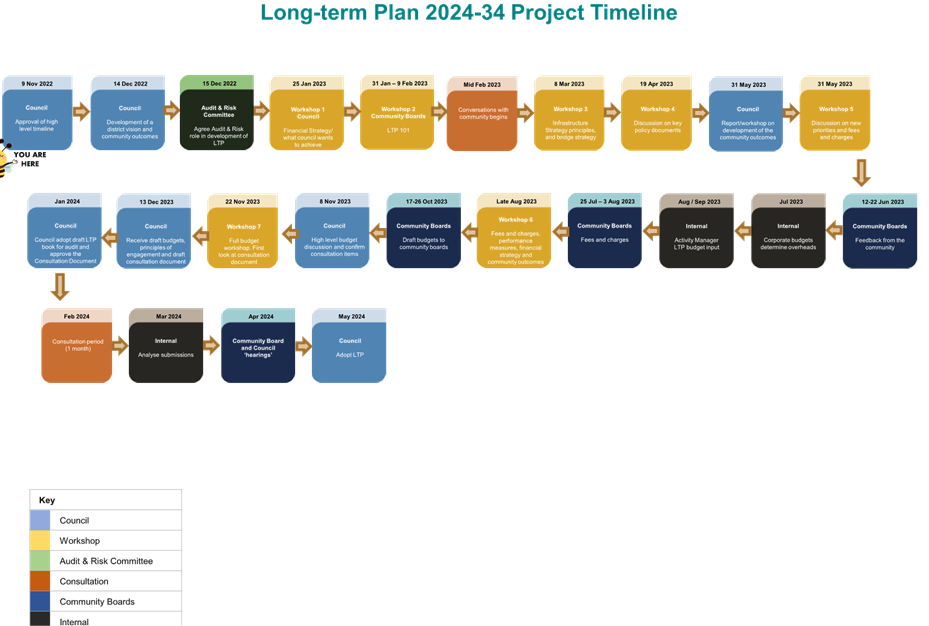

22.9.9 Elected
Members' Remuneration 2022-23
Doc ID: 599664
1. Purpose
of Report
To consider the
allocation of elected member remuneration for the 2022-23 year.
|
Recommendations
That the Council
A. Receives
the report and accepts the level of significance.
B. Approves the
annual elected member remuneration as set out in the report.
|
2. Background
The Local Government Act 2002 (LGA) gives the Remuneration Authority (the
Authority) the responsibility for setting remuneration for local government
elected members. Each council is allocated a pool for their remuneration and a
base rate for councillors is also set.
3. Discussion
The Local Government Members (2022/23) Determination 2022 has allocated
the following sums:
· The total pool allocated to Central Otago District Council is
$362,213.
· The minimum allowable remuneration for a councillor is set at
$27,182.
The Council’s recommendation to the Authority must include a
remuneration rate for the base councillor position and rates for all positions
that hold additional responsibilities.
The proposed remuneration is detailed in the tables below and key
considerations in determining the proposed rates.
The role of the Deputy Mayor has significant additional responsibilities
and it is recommended that this role be remunerated at a rate of 1.2 times the
base councillor remuneration.
Four portfolio leads have been confirmed at the inaugural meeting. It is
recommended that each of those four leads be remunerated at a rate of 1.1 times
the base councillor remuneration.
It is proposed that the additional responsibilities faced by councillors
sitting on community boards is also acknowledged. The Authority has
determined that the members of the Cromwell and Vincent Community Boards are
remunerated at approximately twice the rate of the Maniototo and Teviot Valley
boards. Accordingly, it is recommended that councillors who also sit on
the Cromwell and Vincent community boards are remunerated at a rate of 1.18
times the base councillor remuneration and councillors who sit on the Teviot
Valley and Maniototo boards, are remunerated at a rate of 1.09 times the
base. In addition, it is recommended that the extra responsibilities as
Chair of the Vincent Community Board be remunerated at a rate of 1.14 times the
base councillor remuneration.
In addition, it is recommended that elected members of the Audit and Risk
Committee are remunerated at a rate of 1.1 times the base councillor
remuneration. Previously, members who sat on the Audit and Risk Committee
received no additional compensation for that commitment.
The minimum base rate for a councillor, set by the Remuneration Authority
is $27,182. This proposal suggests a base rate for councillors with no other
responsibilities of $27,234. This proposal fully allocates the pool as required
by the determination.
Position
|
Number
|
Ratio to
base remuneration
|
|
Deputy
Mayor
|
1
|
1.2
|
|
Portfolio Lead
|
4
|
1.10
|
|
Audit
and Risk
|
3
|
1.10
|
|
Community Board
Chair (VCB)
|
1
|
1.14
|
|
Community
Board Member CCB / VCB
|
5
|
1.18
|
|
Community Board
Member TVCB / MCB
|
2
|
1.09
|
|
Base
Councillor
|
2
|
1
|
|
Name
|
Positions
held
|
Proposed ratio to base
|
Base rem
|
Additional rem
|
Annual rem
|
|
Cr N Gillespie
|
· Deputy Mayor (0.2)
· CCB member (0.18)
· Portfolio lead (0.10)
· Audit and Risk (0.10)
|
1.58
|
27,234
|
15,796
|
43,030
|
|
Cr T Alley
|
· VCB
member (0.18)
· VCB
Chair (0.14)
· Portfolio
lead (0.10)
· Audit
and Risk (0.10)
|
1.52
|
27,234
|
14,162
|
41,396
|
|
Cr T Paterson
|
· VCB member (0.18)
· Audit and Risk (0.10)
|
1.28
|
27,234
|
7,626
|
34,860
|
|
Cr S Duncan
|
· Portfolio
Lead (0.10)
· MCB
member (0.09)
|
1.19
|
27,234
|
5,174
|
32,409
|
|
Crs S Browne,
C Laws and
M McPherson
|
· CCB/VCB members (0.18)
|
1.18
|
27,234
|
4,902
|
32,136
|
|
Cr N McKinlay
|
· Portfolio
lead (0.10)
|
1.10
|
27,234
|
2,723
|
29,957
|
|
S Feinerman
|
· TVCB member (0.09)
|
1.09
|
27,234
|
2,451
|
29,685
|
|
Crs I Cooney and L Claridge
|
· Councillor
|
1.00
|
27,234
|
0
|
27,234
|
4. Financial
Considerations
The allocation of money given to Central Otago
District Council is set by the Remuneration Authority. It is unable to be
contested and must be allocated in its entirety.
5. Options
Option 1 –
(Recommended)
The Council has no option but to allocate the full pool of $362,213 and
the proposal in the report does that. Council is free to consider alternative
options for allocating the pool, but any alternative must ensure full
allocation and be able to be justified to the Authority.
6. Compliance
|
Local Government Act 2002 Purpose Provisions
|
This decision enables democratic local decision making and action
by, and on behalf of communities by setting elected member remuneration that
is unable to be contested.
|
|
Decision consistent with other Council plans and policies? Such as
the District Plan, Economic Development Strategy etc.
|
It is required by law to be accepted, so whether it adheres to
council policies is not applicable
|
|
Considerations as to sustainability, the environment and climate
change impacts
|
There are no considerations to be made regarding this decision.
|
|
Risks Analysis
|
There are no risks associated with this decision.
|
|
Significance, Consultation and Engagement (internal and external)
|
This decision does not trigger any provisions in the
Significance and Engagement Policy.
|
7. Next
Steps
A spreadsheet
reflecting these amounts will be submitted to the Remuneration Authority for
their consideration. Following acceptance, the new figures will be gazetted and
released early in 2023. Any extra money that needs to be back paid to members
will be done at that time.
8. Attachments
Nil
|
Report
author:
|
Reviewed
and authorised by:
|
|

|

|
|
Wayne
McEnteer
|
Saskia
Righarts
|
|
Governance
Manager
|
Group
Manager - Business Support
|
|
27/10/2022
|
27/10/2022
|
22.9.10 Pecuniary
Interests Register
Doc ID: 591919
1. Purpose
of Report
To consider a new process
for declaring pecuniary interests in response to the Local Government
(Pecuniary Interests Register) Amendment Act 2022.
|
Recommendations
That the Council
A. Receives
the report and accepts the level of significance.
B. Notes the
requirement for elected members to complete and make publicly available their
pecuniary interests in accordance with the Local Government (Pecuniary
Interests Register) Amendment Act 2022.
C. Notes the Governance
Manager is the registrar of the pecuniary interests register.
D. Notes the process
for the collection of information for the register.
|
2. Background
The Local Government
(Pecuniary Interests Register) Amendment Act 2022 passed on 20 May 2022 and
will come into force on 20 November 2022. It inserts a new set of requirements
and obligations into the Local Government Act 2002 which relate to
members’ pecuniary interests.
Every council will now
be required to keep a register of pecuniary interests for its elected members.
A summary of this register will be publicly available on the council website.
3. Discussion
The Local Government
(Pecuniary Interests Register) Amendment Act 2022 sets out a number of
obligations for elected members to disclose their interests in companies,
trusts (trustee and beneficiary) as well as their real assets. This will then
be kept on a register which will be summarised and be made publicly available
on the website.
Appointment of a
Registrar
Each council must appoint
a registrar to collect and collate the information and to liaise with elected
members to answer questions that may arise. Legislation requires that a
registrar be appointed to oversee the register. While any member of staff could
be appointed to this role, the Governance Manager is in regular communication
with elected members and is in good position to maintain the register.
Obligations for
Elected Members
Elected members have
obligations each year to correctly complete their pecuniary interests for the
preceding year. Any interest that existed at any time during the preceding 12
months must be disclosed.
In each triennium, the
due dates for return are:
(a)
Year 1: the day that is 120 days after the date on which the member comes into
office under section 115 of the Local Electoral Act 2001;
(b)
Year 2: the last day of February in the second year of the triennium; and
(c)
Year 3: the last day of February in the third year of the triennium.
Note that it will be an
offence for an elected member to fail to file a return by the due date, file a
false return or fail to advise the registrar of an error or omission. Members
are liable for a fine of up to $5000 per offence. It should also be noted that
the staff are not responsible for ensuring that elected members comply with the
law, it is their individual responsibility.
Please note that the due
date for the 2023 return will be Sunday 12 February 2023 (however, to enable
the forms to be efficiently collated and published on the website it is
requested members return their forms by midday Friday 10 February 2023).
Limits
The law extends to all
elected members on both council and community board. However, it does not
include members that have been appointed, for instance the independent chair of
the Audit and Risk Committee.
Proposed Process
The proposed process is
as follows:
· The form will be
sent out to members to complete at least 1 month prior to its due date
· Members will send
back their forms
· The Registrar will
update the interest register on the website
Although it is the
members’ responsibility to make sure this paperwork is returned, the
registrar will remind members of impending deadlines.
4. Financial
Considerations
There are no financial considerations as a result of
this decision.
5. Options
Option 1 –
(Recommended)
Adopt the Pecuniary
Interests (Elected Members) Policy.
Advantages:
· Adherence
to the law.
· Will
ensure a greater level of public confidence and transparency in decision
making.
Disadvantages:
· None
identified.
There are no other
viable options as this requirement has been mandated in law.
6. Compliance
|
Local Government Act 2002 Purpose Provisions
|
This decision promotes the wellbeing of communities, in the
present and for the future by allowing greater transparency of members’
interests during decision making.
|
|
Decision consistent with other Council plans and policies? Such as
the District Plan, Economic Development Strategy etc.
|
Yes
|
|
Considerations as to sustainability, the environment and climate
change impacts
|
There are no considerations in regards to environmental impacts
except to note the collation of information will be an electronic process.
|
|
Risks Analysis
|
There are no risks to adopting this policy as it will represent
adherence to the law.
|
|
Significance, Consultation and Engagement (internal and external)
|
This does not trigger consultation under the Significance and
Engagement Policy
|
7. Next
Steps
· A registrar will be appointed.
· A formal mechanism to collate and display the captured data will be
developed.
· A workshop will be provided to elected members, so that they are
aware of their obligations under the law.
· A template for members to provide the required information will be
developed and presented in the workshops.
8. Attachments
Nil
|
Report
author:
|
Reviewed
and authorised by:
|
|

|

|
|
Wayne
McEnteer
|
Saskia
Righarts
|
|
Governance
Manager
|
General
Manager – Business Support
|
|
26/10/2022
|
26/10/2022
|
22.9.11 Residents'
Survey 2022 - summary of results
Doc ID: 600508
1. Purpose
To consider the summary
report of the Central Otago District Council 2022 Residents’ Survey.
|
Recommendations
That the report be received.
|
2. Discussion
The Residents’
Survey is carried out annually to measure how the community view Council
performance with respect to the services it provides during the year. The
survey also goes some way to identifying current issues and priorities for the
upcoming year.
This is the seventh year
Council has conducted its survey online, and the first using new consultation
software, Let’s Talk Central Otago.
A summary report has
been prepared to provide feedback to Council on residents’ satisfaction
with services and amenities provided during the twelve months between 1 July
2021 through to 30 June 2022.
One-hundred and
eighty-three people took the survey and fully completed all the mandatory
questions. This response rate is lower than previous
years. Over the four years from 2018 to 2021, the average response rate is 590,
with a gradual decline since 2019.
The low response rate in
2022 could be due to the following reasons:
· This was the seventh survey conducted
by Council within a six-month period and may have caused survey fatigue within
the community.
· Project outcomes have not
consistently reflected community voice from survey responses and this, combined
with controversial programmes such as the Three Waters debate, may have caused response
apathy in the community.
· The new online consultation platform
required respondents to register (setting up a username and password and
providing demographic information) before completing the survey. This may have
deterred people from engaging.
Despite the lower
response rate, the levels of satisfaction by percentage have not changed
markedly from previous years across most questions in the survey.
3. Attachments
Appendix 1 - Residents Survey
report.pdf ⇩
|
Report
author:
|
Reviewed
and authorised by:
|
|

|

|
|
Genevieve
Heal
|
Sanchia
Jacobs
|
|
Communications
Officer
|
Chief
Executive Officer
|
|
21/10/2022
|
28/10/2022
|
|
Council
meeting
|
9
November 2022
|

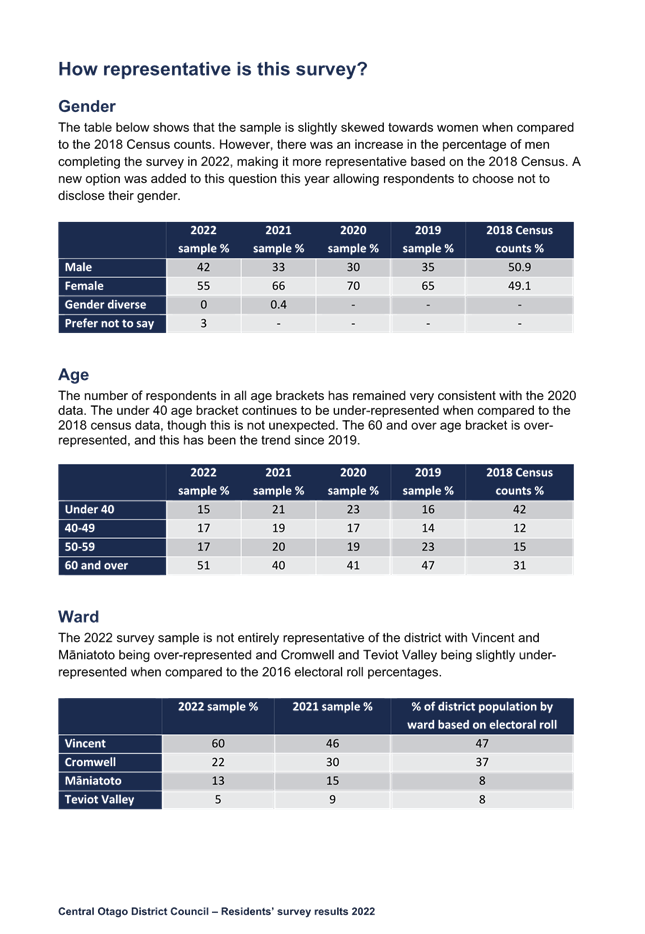

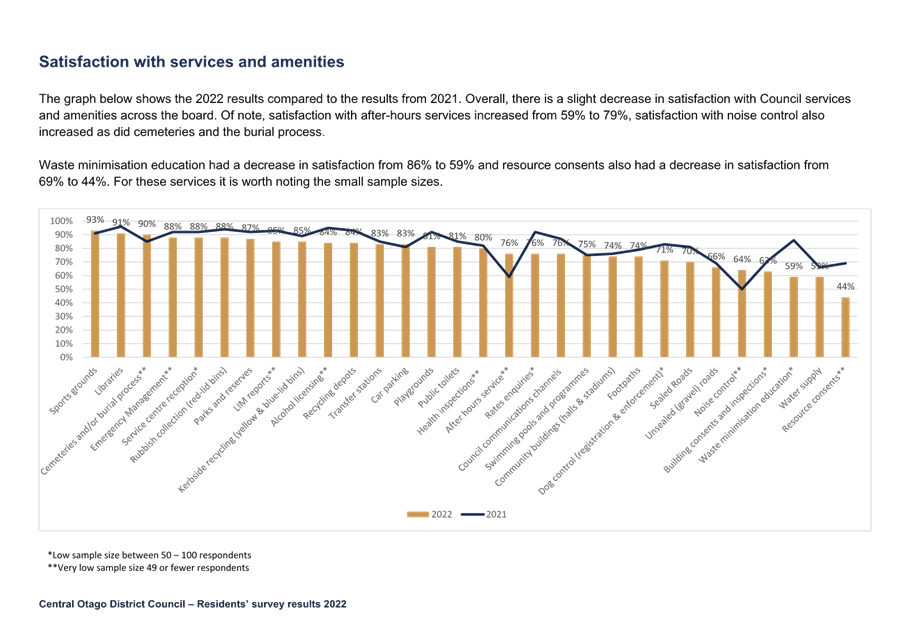
I. Statement of Financial Performance for the
period ending 30 September 2022
|
2022/23
|
3 MONTHS ENDING 30 SEPTEMBER 2022
|
|
2022/23
|
|
|
|
YTD
|
YTD
|
YTD
|
|
|
|
Annual Plan
|
|
Actual
|
Revised Budget
|
Variance
|
|
Revised Budget
|
|
$000
|
|
$000
|
$000
|
$000
|
|
$000
|
|
|
Income
|
|
|
|
|
|
|
36,238
|
Rates
|
9,081
|
8,988
|
93
|
˜
|
36,238
|
|
6,062
|
Govt Grants
& Subsidies
|
1,211
|
1,645
|
(434)
|
˜
|
6,552
|
|
8,161
|
User Fees
& Other
|
1,274
|
1,928
|
(654)
|
˜
|
8,729
|
|
14,930
|
Land Sales
|
-
|
-
|
-
|
˜
|
14,930
|
|
2,233
|
Regulatory
Fees
|
812
|
558
|
254
|
˜
|
2,233
|
|
2,192
|
Development
Contributions
|
2,252
|
548
|
1,704
|
˜
|
2,192
|
|
500
|
Interest &
Dividends
|
42
|
125
|
(83)
|
˜
|
500
|
|
-
|
Reserves
Contributions
|
291
|
-
|
291
|
˜
|
-
|
|
-
|
Profit on Sale
of Assets
|
23
|
-
|
23
|
˜
|
-
|
|
40
|
Other Capital
Contributions
|
83
|
8
|
75
|
˜
|
41
|
|
70,356
|
Total Income
|
15,069
|
13,800
|
1,269
|
˜
|
71,415
|
|
|
|
|
|
|
|
|
|
|
Expenditure
|
|
|
|
|
|
|
13,876
|
Staff
|
3,193
|
3,506
|
313
|
˜
|
14,207
|
|
603
|
Members
Remuneration
|
114
|
151
|
37
|
˜
|
603
|
|
8,918
|
Contracts
|
2,657
|
2,266
|
(391)
|
˜
|
9,185
|
|
2,735
|
Professional
Fees
|
739
|
795
|
56
|
˜
|
3,304
|
|
10,857
|
Depreciation
|
2,714
|
2,714
|
-
|
˜
|
10,857
|
|
11,232
|
Costs of Sales
|
4
|
1,004
|
1,000
|
˜
|
11,232
|
|
4,182
|
Refuse &
Recycling Costs
|
865
|
1,045
|
180
|
˜
|
4,182
|
|
-
|
Cost Allocations
|
(4)
|
-
|
4
|
˜
|
-
|
|
1,799
|
Repairs &
Maintenance
|
518
|
480
|
(38)
|
˜
|
1,911
|
|
1,433
|
Electricity
& Fuel
|
214
|
353
|
139
|
˜
|
1,421
|
|
636
|
Grants
|
884
|
359
|
(525)
|
˜
|
763
|
|
1,118
|
Technology
Costs
|
319
|
294
|
(25)
|
˜
|
1,095
|
|
378
|
Projects
|
124
|
329
|
205
|
˜
|
1,289
|
|
658
|
Rates Expense
|
468
|
164
|
(304)
|
˜
|
658
|
|
474
|
Insurance
|
157
|
118
|
(39)
|
˜
|
474
|
|
526
|
Interest
Expense
|
51
|
69
|
18
|
˜
|
526
|
|
2,133
|
Other Costs
|
439
|
551
|
112
|
˜
|
2,243
|
|
61,558
|
Total Expenses
|
13,456
|
14,198
|
742
|
˜
|
63,950
|
|
|
|
|
|
|
|
|
|
8,798
|
Operating Surplus /
(Deficit)
|
1,613
|
(398)
|
2,011
|
|
7,465
|
This table has rounding
(+/- 1)
The financials for September 2022
show an overall favourable variance of $2.011M. Development and reserve
contributions are higher than budget. This is predominately due to the timing
subdivisions in Cromwell and when the invoicing of contributions occurs. Grants
and subsidies are ($434k) behind budget. This is due to the timing of Waka
Kotahi subsidies ($796k), which is offset by $489k of Strategic Tourism Assets
Protection Programme (STAPP) funding that has been carried over from the prior
financial year. User fees and charges are ($654k) behind budget. This is due to
the timing of metered water sales ($431k) and ($125k) relates to the
contributions for the Otago/Southland Three Waters Director position.
|
Council
meeting Agenda
|
9
November 2022
|
Income of $15.069M against the
year-to-date budget of $13.800M
Overall, income has a favourable variance
against the revised budget by $1.2M. This is being driven by the timing of
development contributions with a variance of $1.7M (F), offset by the timing of
Waka Kotahi subsidies (U) and metered waters sales (U).
The main variances are:
· Government
grants and subsidies ($434k) U - This is mainly due to the timing of the
Waka Kotahi New Zealand Transport Agency (Waka Kotahi) roading subsidy
contributing an unfavourable variance of ($796k). Subsidies are claimed for
both the operational and capital roading work programmes and fluctuate based on
the work programme. Tourism Central Otago has brought forward from the prior
year $489k of Strategic Tourism Assets Protection Programme (STAPP) funding
from Ministry of Business, Innovation and Employment (MBIE) funding.
· User
fees and other ($654k) U – Metered water sales has a variance of
($431k). The first meter readings of the financial year will be carried out over October, November and December 2022.
· Land
sales no variance – these are programmed for later in the financial
year and are recognised in tandem with costs of sales.
· Regulatory
fees $254k F – Majority of the dog registration revenue has been
received in July 2022 creating a favourable variance of $165k. This is due to
the budget being spread over 12-months rather than the dog registration period.
Building permit fees are also higher than budget by $77k.
· Development
Contributions $1.7M F - This variance relates to the timing of development
contributions which are dependent on the resource consent process and developer
timeframes. Cromwell development contributions in wastewater, water and roading
are higher than budgeted.
· Interest
and dividends revenue ($83k) U - Large project costs are being managed
within current cashflows rather than uplifting additional loan funding (this includes
subdivision development costs which are held on the balance sheet). This
results in less cash available to be invested. At the time of writing this
report there is $4M in term deposits earning interest.
· Reserves
contributions $291k F - These are difficult to gauge when setting budgets
and are dependent on developers’ timeframes. As with development
contributions above, these are mainly for the Cromwell area.
Expenditure of $13.456M
against the year-to-date budget of $14.198M
Expenditure has a favourable variance of
$742k. The main drivers behind this are cost of sales, staff, and projects.
Offsetting this favourable variance is contracts, grants, and rates expenses.
The main variances are:
· Staff
costs $313k F - The is due in part to the lag between staff movements and
the replacement of new staff, plus the relevant recruitment costs.
· Contracts
($391k) U - Contract expenditure is determined by workflow and the time of
the contract. The outcome of this is that the phased budgets will not
necessarily align with actual expenditure, meaning some work appears
favourable, and some contracts spend year-to-date appear unfavourable. Physical
works contracts ($393k), roading contracts ($203k), contracts ($25k) and
planned maintenance $231k are the key timing variances year-to-date. The
physical works contracts variance relates to water supply operations ($248k)
and wastewater operations ($189k). The wastewater operations variance is due to
the July 2022 flooding event where the Omakau treatment pond was flooded. $165k
of the repair cost is being funded through the emergency works fund. The water
supply operations have seen an increase in service requests and re-active
repairs.
· Costs of sales $1.00M F
- Costs of sales is linked to the land sales mentioned earlier and reflect the
development costs for subdivisions. The subdivision development costs are held
on the balance sheet in ‘property intended for sale’ until each
stage is complete and land sales are received. There have been no land sales in
the first quarter to allocate out development costs to costs of sales.
· Refuse and recycling costs $180k F – The waste management activity can fluctuate
depending on the amount of waste being managed.
· Electricity
& Fuel $139k F - This is due to a lag in receiving electricity invoices,
September invoicing was not available at the time of preparing this report.
· Grants
($525k) U – This is predominately due to the Roxburgh Pool grant of
$500k. This grant was recognised in the 2021/22 Annual Plan. The remaining
variance is due to the timing of Central Stories Museum grant funding.
· Projects
$205k F - This is due to the phasing schedule of Tourism Central Otago
projects and the costs incurred for the Southland Otago Three Waters Director
position. The Southland Otago Three Waters Director
position is a cost share arrangement with other councils in the area to assist
with the Three Waters reform.
· Rates
Expense ($304k) U – Central Otago rates expenses for 2022/23 on
council owned property has been recognised in full in July 2022, while the
budget has been recognised over 12-months.
· Other
costs $112k F - A detailed breakdown for other costs is tabled below.
Other costs breakdown
|
2022/23
|
|
YTD Actual
|
YTD Revised Budget
|
YTD Variance
|
|
2022/23
|
|
Annual Plan
|
Other Costs breakdown
|
|
Revised Budget
|
|
$000
|
|
$000
|
$000
|
$000
|
|
$000
|
|
625
|
Administrative
Costs
|
141
|
167
|
26
|
˜
|
678
|
|
673
|
Office
Expenses
|
141
|
172
|
31
|
˜
|
662
|
|
229
|
Operating
Expenses
|
71
|
54
|
(17)
|
˜
|
229
|
|
352
|
Advertising
|
11
|
91
|
80
|
˜
|
415
|
|
178
|
Valuation
Services
|
61
|
45
|
(16)
|
˜
|
178
|
|
76
|
Retail
|
14
|
22
|
8
|
˜
|
81
|
|
2,133
|
Total Other Costs
|
439
|
551
|
112
|
|
2,243
|
This table has rounding (+/- 1)
· Other costs include only need based costs which will
fluctuate against budget from time-to-time. There are no significant variances
of note to report on at present.
II. Profit and Loss by Activity for the period ending
30 September 2022

This
table has rounding (+/- 1)
*
The funding activity has been removed as this is not an operational activity.
· Infrastructure $1.66M F – income has a favourable
variance of $1.57M. This is due to the timing of development contribution
revenue. Cromwell development contributions in wastewater, water and roading
are higher than budgeted. Expenditure has a favourable variance of $86k. This
department is fully on-charged as an overhead. This variance is due to the
Southland Otago Three Waters Director position. This is a cost share
arrangement with other councils in the area to assist with the Three Waters
reform.
· Roading ($974k) U – income has an unfavourable
variance of ($784k). This is predominately due to the Waka Kotahi subsidy. This subsidy moves in conjunction with the
subsidised roading operating and capital work programmes. Operating expenditure
has an unfavourable variance of ($190k). This is mainly due to contracts
($198k) and professional fees ($77k). The capital work programme has a year-to-date
favourable variance of $2.12M.
· Waste Management ($12k) U - income has an unfavourable variance of ($107k). User fees and charges are behind
budget, these fluctuate based on transfer station users. Expenditure has a
favourable variance of $95k. This is due to the waste and recycling costs,
which fluctuate based on the volume of waste being processed.
· Parks and Recreation ($340k) U – income has an unfavourable
variance of ($48k). This is mainly due to user fees being ($49k) lower than
revised. This is made up of camp fees ($43k), admissions ($17k) and rentals and
hires ($16k). This is offset by higher-than-expected swim school income of
$16k. Expenditure has an unfavourable variance of ($292k). The Roxburgh Pool
grant of $500k was recognised in the 2021/22 Annual Plan and is creating the
unfavourable variance. The remaining favourable variance of $196k is due to the
timing of workplans with underspends in planned maintenance $165k and physical
works contracts $27k.
· Corporate Services ($35k) U – income has a small favourable
variance of $1k. Expenditure has an unfavourable variance of ($36k). This is
mainly due to computer maintenance and support ($28k) and equipment hire
($16k).
· People and Culture $40k F – income has a small favourable
variance. Expenditure has a favourable variance of $39k. Driving these variances are underspends in libraries $28k
and service centres $40k. This is offset by overspends in human resources
($10k) and administration ($23k).
· CEO $254k F – income has an unfavourable
variance of ($4k). Expenditure has a favourable variance of $258k. This is
mainly due to the timing and need for professional fees $53k, staff costs $161k
and strategic planning $21k.
· Property $1.12M F – income has a favourable
variance of $103k. User fees and other is higher than budget by $79k due to
annual lease payments. The Transpower capital grant of $29k has also been
carried forward from the prior year for the Clyde Hall kitchen and bathroom
project. Expenditure has a favourable variance of $1.02M. The timing of
the cost of sales budgets for subdivisions is creating a favourable variance of
$1.0M. Excluding the cost of sales variance there is a small favourable
variance of $6k. Community buildings $29k, Council offices $13k and public
toilets $20k are offset by commercial and other property ($61k). The commercial
and other property variance is due to the Central Otago properties rates
expense for 2022/23. The rates expense is recognised in full in July each
year.
· Governance and Community Engagement
$484k F –
income has a favourable variance of $423k. This due to the budget phasing of
the STAPP funding carried over from the previous financial year. Expenditure
has a favourable variance of $61k. This is due to underspends in community
development $45k and regional identity $44k. This is offset by promotions and
tourism variance of ($33k). This relates to the phasing schedule for the
Tourism Central Otago projects.
· Planning (Regulatory) $395k F – has a favourable income
variance of $194k. This is mainly due to dog registration fees of $159k and an
increase in building permits revenue of $77k. These are offset by lower than
budgeted professional fee recoveries ($63k). Expenditure has a favourable
variance of $201k. This is due to the timing and need of planning consultants
$84k, staff costs $113k and contracts $43k.
· Three Waters ($870k) U – income has an unfavourable
variance of ($380k). This is mainly due the timing of metered water sales
($431k), water meters will be read over October, November and December 2022. Expenditure
has an unfavourable variance of ($490k). Driving this unfavourable variance are
the water supply operations ($248k) and wastewater operations ($189k) physical
works contracts. As mentioned above, wastewater operations variance is due to
flooding expenses from the Omakau event in July 2022 and the water supply
operations has seen an increase in service requests and reactive repairs in the
first quarter.
III. Capital Expenditure
Year-to-date, 12%
of the total capital spend against the full year’s revised capital
budget, has been expensed.
|
|
|
|
|
|
2022/23
|
Progress to date against revised budget
|
|
CAPITAL EXPENDITURE
|
YTD Actual
|
YTD Revised Budget
|
YTD Variance
|
|
Revised Budget
|
|
|
$000
|
$000
|
$000
|
|
$000
|
|
|
|
|
|
|
|
|
|
Council
Property and Facilities
|
563
|
5,023
|
4,460
|
˜
|
24,516
|
2%
|
|
Waste
Management
|
12
|
226
|
214
|
˜
|
905
|
1%
|
|
Customer
Services and Administration
|
6
|
24
|
18
|
˜
|
95
|
6%
|
|
Vehicle Fleet
|
-
|
73
|
73
|
˜
|
597
|
0%
|
|
Planning
|
1
|
102
|
101
|
˜
|
407
|
0%
|
|
Information
Services
|
88
|
272
|
184
|
˜
|
1,493
|
6%
|
|
Libraries
|
10
|
120
|
110
|
˜
|
492
|
2%
|
|
Parks and
Recreation
|
163
|
581
|
418
|
˜
|
2,551
|
6%
|
|
Roading
|
539
|
2,484
|
1,945
|
˜
|
9,937
|
5%
|
|
Three Waters
|
7,972
|
8,583
|
611
|
˜
|
34,334
|
23%
|
|
|
|
|
|
|
|
|
|
Grand Total
|
9,354
|
17,488
|
8,134
|
|
75,327
|
12%
|
This
table has rounding (+/- 1)
Council Property and
Facilities $4.46M F - This is mainly due to the
timing of the Cromwell Town Centre Projects which is currently underspent by
$3.994M. This includes the Memorial Hall project, Cromwell Administration
Buildings projects and grounds, paths and fences around the Town Centre. Other
areas behind budget include airports $323k, public toilets $125k and elderly
person housing $35k.
Waste Management
$214k F - The transfer station reconfiguration projects are
contributing to $183k of the underspend. The Greenwaste processing project has
not yet started.
Vehicle
Fleet $73k F - Vehicle renewals and purchases are under budget.
The vehicle renewals programme has started, however there are expected delays
due to supply global constraints.
Planning
$101k F - This relates to the timing of the dog pounds and dog registration
software projects. These were carried forward from the 2022/23 financial year
and have not started yet.
Information
Services $184k F - Information Services projects are behind budget.
Projects include enhanced customer experience projects $17k, financial
performance improvement $59k, and geographic information systems $81k.
Libraries $110k F - This is due to the timing of the Alexandra Library
building upgrade. Currently this project is in the design phase.
Parks
and Recreation $418k F - This is driven by a mixture of the timing of
project budgets, work programmes and contractor’s availability to perform
the work. Parks and reserves are favourable by
$214, with major projects including: Alexandra River Park $66k, Omakau Tennis
Courts surface upgrade $47k, Anderson Park $16k, Maniototo reserves $14k, other
Alexandra reserves $15k and Pioneer Park $12k. Swimming pools has a favourable
variance of $133k, including Cromwell Pool $108k and Alexandra Pool $25k.
Roading
$1.94M F - This is due to the timing of the budget and work programme.
Roading projects include footpath renewals $116k, carpark renewals $14k, seal
extensions $100k, structures renewals $109k, minor improvements $862k, sealed
road renewals $386k, gravel road renewals $390 and drainage renewals ($50k).
Three Waters $611k F - This is due to the timing of
construction projects. These can be ahead of budget or behind because of the
project work programme. The main drivers include the Lake Dunstan water supply
($1.9M), Cromwell water treatment plant and capacity upgrades $1.73M, Clyde
wastewater improvements ($614k), water supply renewals $735k and wastewater
renewals $141k.
IV. Internal
Loans
Forecast closing balance for 30 June 2023 is $4.14M.
|
OWED BY
|
Original Loan
|
1 July 2022
|
30 June 2023 Forecast
|
|
Opening Balance
|
Closing Balance
|
|
Public Toilets
|
670,000
|
468,048
|
443,899
|
|
Tarbert St Bldg
|
25,868
|
11,574
|
10,019
|
|
Alex Town Centre
|
94,420
|
44,545
|
39,117
|
|
Alex Town Centre
|
186,398
|
79,921
|
68,342
|
|
Alex Town Centre
|
290,600
|
139,137
|
122,048
|
|
Centennial Milkbar
|
47,821
|
18,192
|
14,973
|
|
Vincent Grants
|
95,000
|
9,500
|
0
|
|
Pioneer Store Naseby
|
21,589
|
9,609
|
8,213
|
|
Water
|
867,000
|
691,212
|
663,496
|
|
ANZ Bank Seismic
Strengthening
|
180,000
|
143,504
|
137,750
|
|
Molyneux Pool
|
650,000
|
563,650
|
531,150
|
|
Maniototo Hospital
|
1,873,000
|
1,723,630
|
1,670,314
|
|
Alexandra Airport
|
218,000
|
197,216
|
189,584
|
|
Roxburgh Community Pool
Upgrade*
|
250,000
|
-
|
241,384
|
|
Total
|
5,469,695
|
4,099,738
|
4,140,288
|
This table has rounding (+/- 1)
*The Roxburgh Pool loan has no opening balance as it
has been uplifted in the 2022/23 financial year.
V. External
Loans
The total amount of external loans at
the beginning of the financial year 2022-23 was $134k. As at 30 September 2022,
the outstanding balance was $119k. Council has received $14.2k in principal
payments and $1.8k in interest payments.
|
Owed By
|
Original Loan
|
1 July 2022
Actual
Opening Balance
|
Principal
|
Interest
|
30 September 2022
Actual
Closing Balance
|
|
Cromwell College
|
400,000
|
95,351
|
9,181
|
1,347
|
86,169
|
|
Maniototo Curling
|
160,000
|
21,910
|
3,546
|
259
|
18,364
|
|
Oturehua Water
|
46,471
|
16,844
|
1,508
|
210
|
15,354
|
|
|
606,471
|
134,105
|
14,235
|
1,816
|
119,887
|
This table has rounding (+/- 1)
Reserve
Funds table
· As
at 30 June 2022 the Council had an unaudited closing reserve funds balance of
$281k. This reflects the whole district’s reserves and factors in the
district-wide reserves which are in deficit at ($27.814M). Refer to Appendix 1.
· Taking
the 2021-22 unaudited Annual Report closing balance and adding 2022-23 income
and expenditure, carry forwards and resolutions, the whole district is
projected to end the 2022-23 financial year with a closing deficit of
($32.026M). This is dependent of all capital funding being expensed, and
based on year-to-date and current comments, this is not a realistic
expectation, meaning the reserves should finish with a more favourable result
than currently forecast.
3. Attachments
Appendix 1 - CODC Reserve Funds
2022-23 ⇩
|
Report
author:
|
Reviewed
and authorised by:
|
|

|

|
|
Ann
McDowall
|
Saskia
Righarts
|
|
Finance
Manager
|
Group
Manager - Business Support
|
|
19/10/2022
|
22/06/2022
|
|
Council
meeting
|
9 November
2022
|
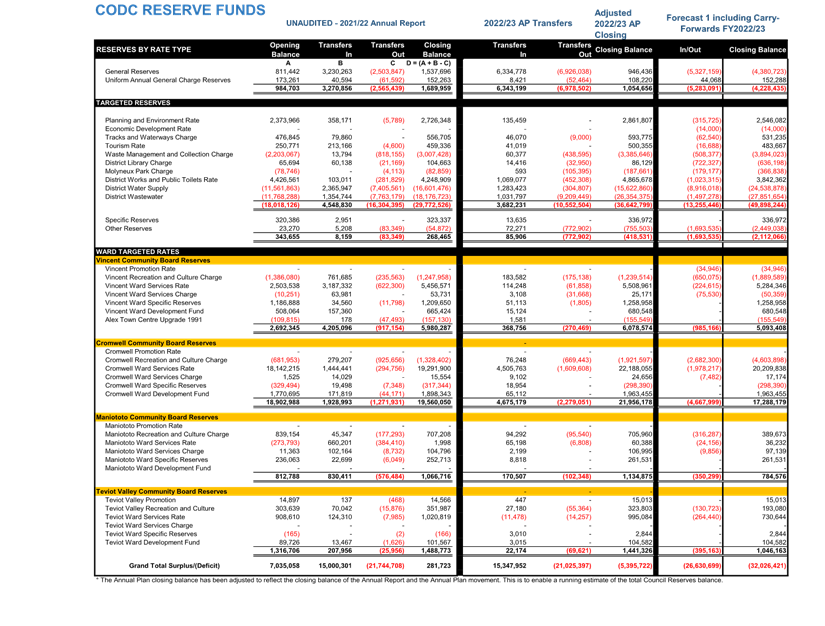
6 Mayor’s
Report
22.9.13 Mayor's
Report
Doc ID: 601457
1. Purpose
To consider an update
from His Worship the Mayor.
|
Recommendations
That the Council receives the report.
|
And so
begins a new triennium, the third in which I have held the honour of leading
the council and being one of the leaders of this community.
This
poses a good opportunity for reflection and to look ahead over the next three
years and beyond.
Looking
back to the first full meeting of the CODC council that I chaired around this
time in 2016, firstly I reflect on the fact that in the six years since, we
have maintained a good degree of consistency with our elected members while
welcoming dynamic new councillors into the fold. Having talked to other
Mayors at our inaugural meeting last month, I recognise how fortunate I have
been to lead such a steady team and how fortunate the community is to have such
a great bunch of people at the helm for the next three years. I look
forward to working with you all.
Back in
2016, the population we served numbered approximately 20,000 people.
Stats New Zealand last month gave the latest official estimate as being 25,500,
a 25% growth rate in six years. I think I have mentioned this before but
a couple of different ways of looking at this is that 1 in 5 people living in
Central now weren’t living here in 2016, and there have been more people
move here since 2016 than lived in Alexandra back then.
That
sort of population growth puts pressure on a community in many ways, from
infrastructure through to housing through to socially welcoming these new
people. Council’s response through the Cromwell Masterplan and
Vincent Spatial Plan leading to Plan Change 19 is aimed at assisting in the
housing space by making more land available for housing and encouraging
densification. To some, densification is a dirty word, but the reality is
that people want to come and share our place with us and if we want to have any
hope of getting land and house prices more achievable for more people, we need
to make space available. We can either do that by sprawling out over our
magical place, ploughing up great land once for a house, or we can accept
denser living within or near to our current town footprints. We currently
have the Teviot Spatial Plan currently underway to address growth in that
Valley and we have joined the Welcoming Communities programme to find ways to
ensure our new Central Otago folk feel this place is their home as quickly as
possible.
We are
also providing the infrastructure to meet growth and other needs with the
infrastructure build that has been undertaken over the last six years and still
to come constituting the largest amount of capital works ever undertaken in
this District by the council, an amount of mahi probably only rivalled by the
Clyde Dam build overall.
In the
last six years, I have had the honour of dedicating the Cromwell Wastewater
Treatment plant upgrade which cost eight million dollars and I am looking forward
to turning the tap on the Lake Dunstan Water Supply that will bring lower lime
water to Alexandra and fully compliant water to both Clyde and Alexandra next
year as well as commissioning the first stage of the Clyde Wastewater scheme
around the same time at a combined cost of tens of millions of dollars.
Add to
that projects completed such as the Lodge Lane and Miners Lane upgrades
in Clyde and projects well advanced such as Riverside Park in Alexandra, the
Cromwell Town Hall rebuild and the Omakau Community Hub alongside projects in
the pipeline such as the Cromwell drinking water and Omakau drinking water and
wastewater upgrades and the Cromwell Mall redevelopment, as well as projects
council has supported through rates funding like the Maniototo Hospital build
and the Roxburgh Swimming Pool build.
Then
throw into the mix the small matter of a pandemic response and dealing with the
after-effects of that in the community, including inflation levels not seen in
decades and you can see what a busy and challenging six years it has been.
At a
national level CODC has never had such penetration, with our CEO Sanchia Jacobs
holding the role of President of Taituarā (the Local Government
Professionals Aotearoa national body) while I have sat on two Ministerial
Working Groups (remaining on one), Chaired the Otago Mayoral Forum and have
just been appointed to represent the lower South Island on the LGNZ National
Council. These positions allow the viewpoint of the 0.5% of New
Zealand’s population that we serve to be heard far more clearly in
Wellington than other population bases could hope for.
So
that’s the looking back bit done. If the pandemic has taught me
anything it is that crystal ball gazing is a fraught game at the best of times,
but what are the challenges I see ahead over the next three years for us as a
Council to face?
Firstly,
there are the three big reform programmes, each one of them offering
significant threats and opportunities.
The
reform of the Resource Management Act is well underway and has quietly moved
its way along under the public view, or perhaps more accurately within the view
of a disinterested public. This reform, amongst many other things, will
see a reduced ability for territorial authorities to have control over their
growth plans, with the proposed Spatial Planning Act (SPA) requiring the
development of long-term Regional Spatial Strategies (RSSs), effectively
creating regional plans for growth. It is crucial that this council
continues to be heard in this space as this reform progresses while preparing
for the changes to come.
The
Three Waters reforms have dominated the publics interest with plainly a lot of
opposition to the proposal both locally and nationally. A lot of that
opposition fails to recognise the need for radical change in this space and the
complexities involved in meeting the challenge of a combined storm of
under-investment in infrastructure, increased or enforced regulation, changes
in community expectations on environmental impacts and the effects of climate
change. The status quo simply cannot remain and no political party is
saying it can. The first of the Bills that will make the reforms happen
is about to come out of the Select Committee process with the other two due for
First Readings soon. I do not see the Government changing course at this
late stage so we must plan for losing our Three Waters as of July 1,
2024. However, we must at the same time be cognisant of the National and
ACT views that the reforms in their current form will not proceed and that the
tea-leaves suggesting strongly a change of government next year. Add to
that my personal belief that there is no way in the world a new government will
just revert to the status quo, and a lack of clarity as to what they intend to
replace the reforms with, and we have a massive amount of uncertainty over the
third of our business that the Three Waters constitute. As with the RMA
reforms, we need to remain closely involved in all the discussions in this
space and make the best plans and undertake the smartest options we can amongst
nothing but uncertainty.
Then
finally we have the Future for Local Government reform; potentially the biggest
of them all. I fully support the need for a look at the way we do
things. I do not believe that the adage “if it ain’t broke,
don’t fix it” applies here. We had significantly less than
50% of our population vote in the last election and the Cromwell Community
Board, I would say the most powerful community board in the country, is needing
a by-election to fill a vacancy caused by a lack of candidates. To me,
these are symptoms of a broken system, and there are plenty more I could cite.
The
report of the Future for Local Government Panel released late last month, which
the Panel has brilliantly described as a “provocation”, is an
exciting, challenging read. I am really looking forward to the debates
that will come from this document over the next few months and strongly
encourage all councillors as well as everyone in the community to read the
report and get involved in those discussions.
Secondly
looking forward, and speaking of uncertainty, we have two proposals outside of
our control that could transform our district if either or both go ahead.
I refer of course to the Lake Onslow Battery proposal and the Central Otago
International Airport proposal at Tarras. These proposals, if either come
to fruition, will change things here in ways that we cannot imagine. We
as the council that leads the community need to be involved in both these projects
as much as possible as they progress.
Thirdly,
we have matters well within our lane that we need to focus on. Our bridge
strategy and the flow-on mahi and cost from that is going to have a big impact
on our workstream and our costs over the next few years, and especially into
our next Long-Term Plan. The community needs to prepare itself for the
impact of the work that needs to be done, and the changes that may come to our
roading network as a result of the work done on this strategy. The Mayor
legislatively leads the Long-Term Plan and getting our bridges sorted is of
high priority to me.
We need
to finalise the Museum Strategy as a priority too. I am troubled by the
current situation where we have a number of museums planned or in pre-planning
in the district (Cromwell, Clyde and Teviot) and while these do not have
Council money directly involved, two have significant amounts of Board money
earmarked with the third, I am sure, about to put its hand out. The
question needs to be asked if the piecemeal approach we have always used in
this space is the best way forward.
And
clarity is still needed on what council’s role in affordable housing is.
Another
important matter to consider is that we have our six yearly representation
review this triennium. In the last review, we obviated the boundary
between the then Alexandra and Earnscleugh/Manuherikia Wards of the Vincent
Ward and raised the number of councillors in Cromwell by one. I believe
this time around councillors need to have a brave discussion with themselves
and the community as to whether we would be better served by a smaller
council. In addition, the Local Government Electoral Legislation Bill
(currently at Select Committee stage), if passed in its current form, will make
compulsory consideration of specific Māori representation on council and
boards a part of that review. I have no doubt this discussion to come
will be challenging for many in the community, but it is one I personally am
looking forward to and one I hope will be calm and respectfully undertaken by
all concerned.
As I
have said, the Local Government Act states that it is the role of a mayor to
lead the development of the territorial authority’s plans (including the
long-term plan and the annual plan), policies, and budgets for consideration by
the members of the territorial authority. As Mayor, my leadership this
term, especially in relation to the Long-Term Plan is to be one of
consolidation on the work that has been done and needs to be done to put the
next council in the best position to lead the community from 2025 onwards,
whatever the size, shape and roles that council may be after the reforms are
complete. While as always I will be open to the wishes and ideas of the
community, I can say now I will be seeing these through a lens dictated by the
realities that surround us. The line between community wants and
community needs is going to have to be sharply defined over the three years of
this term.
In
conclusion, the next three years are going to be incredibly challenging but also
full of opportunities for this council to make one of the greatest places on
earth even better into the future. I look forward to taking the journey
alongside you all.
2. Attachments
Nil
|
Report
author:
|
|

|
|
Tim
Cadogan
|
|
Mayor
|
|
3/11/2022
|
7 Status
Reports
22.9.14 November
2022 Governance Report
Doc ID: 600993
1. Purpose
To report on items of general interest, receive minutes
and updates from key organisations, consider Council’s forward work
programme, business plan and status report updates.
|
Recommendations
That the Council receives the report.
|
2. Discussion
Forward Work
Programme
Council’s forward
work programme has been included for information (see appendix 1).
Status Reports
The status reports have
been updated with any actions since the previous meeting (see appendix 2).
3. Attachments
Appendix 1 - Council Forward Work
Programme ⇩
Appendix 2 - Council Status
Updates ⇩
|
Report
author:
|
Reviewed
and authorised by:
|
|

|

|
|
Wayne
McEnteer
|
Saskia
Righarts
|
|
Governance
Manager
|
Group
Manager - Business Support
|
|
28/10/2022
|
28/10/2022
|
|
Council
meeting
|
9
November 2022
|
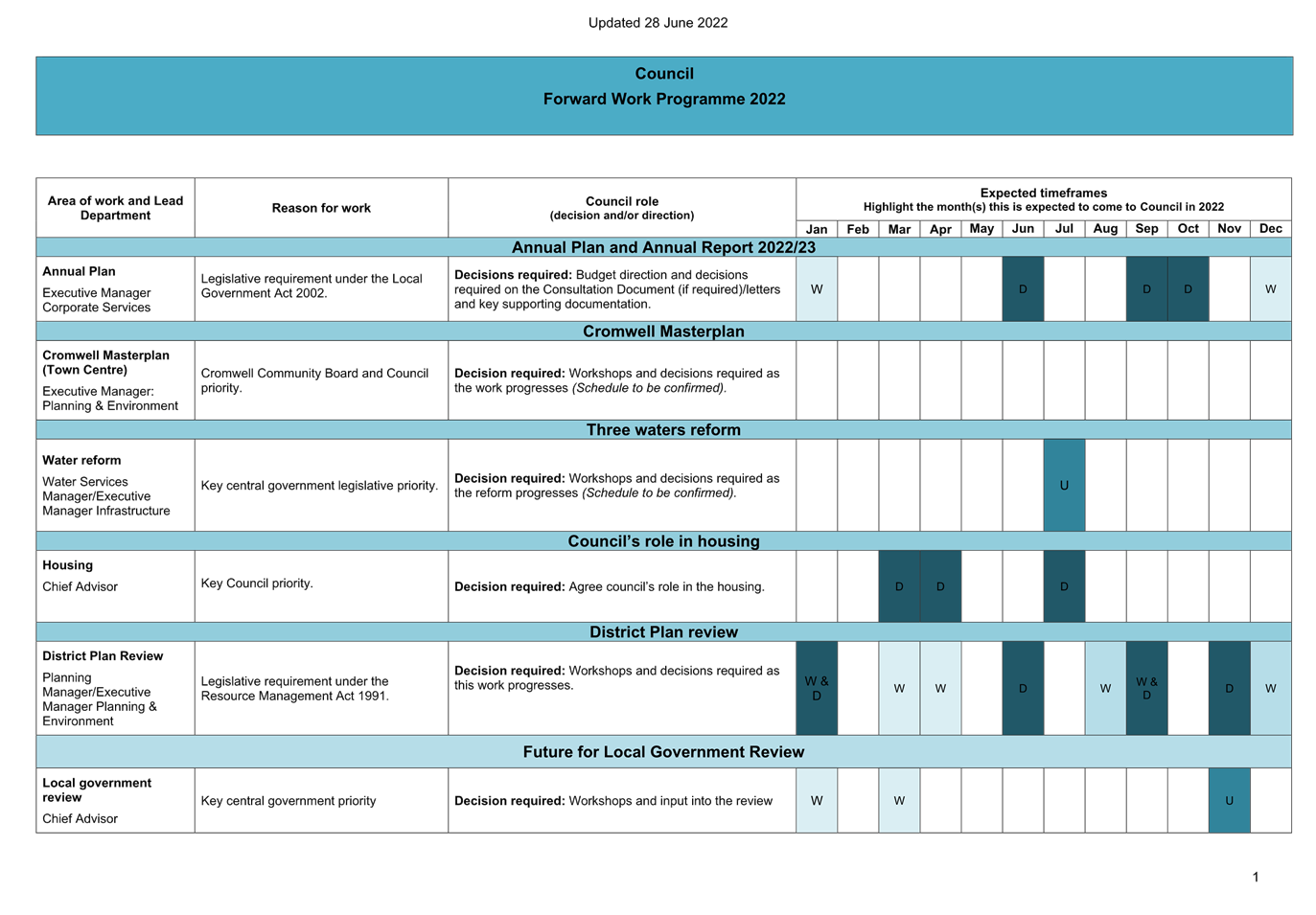

|
Council meeting
|
9
November 2022
|
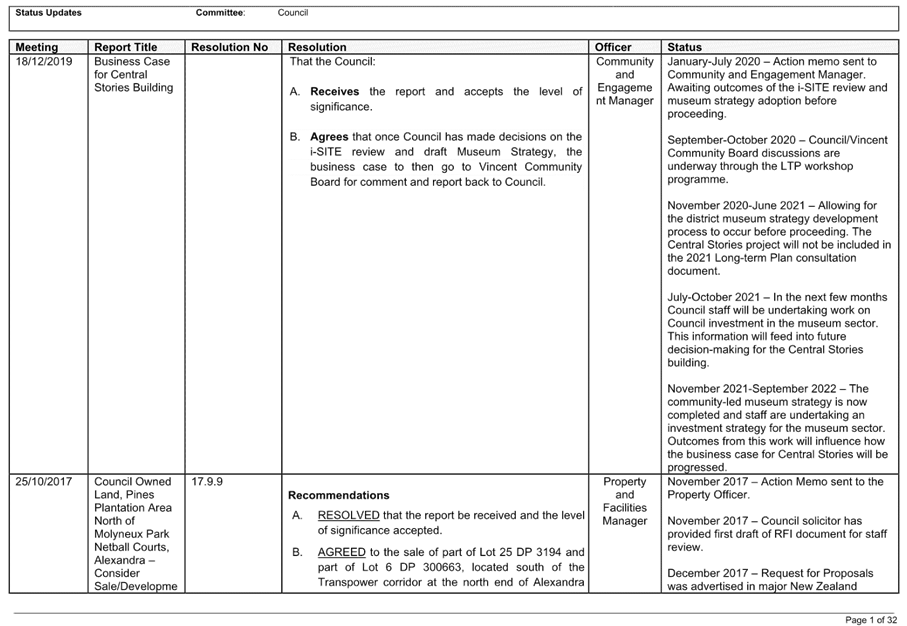
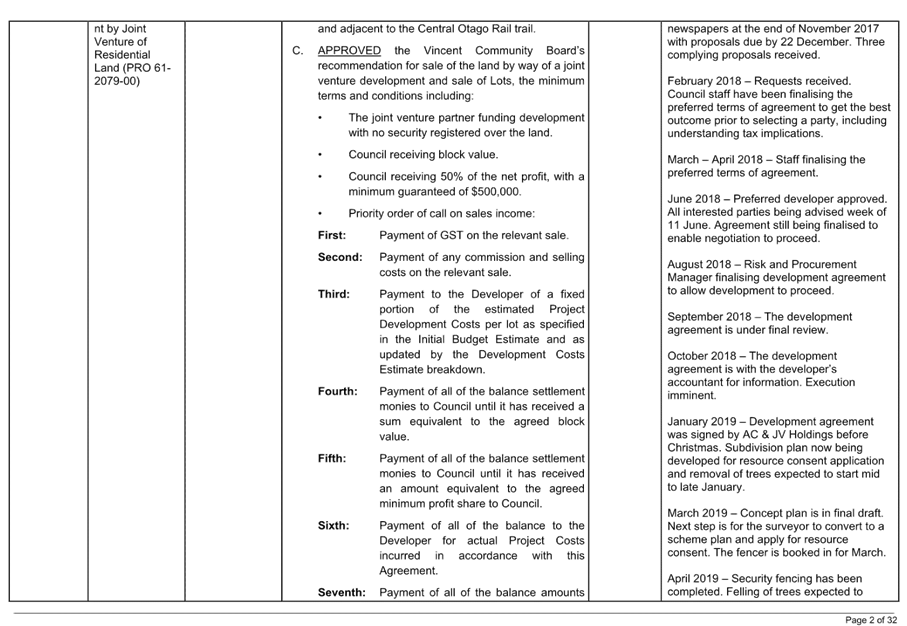


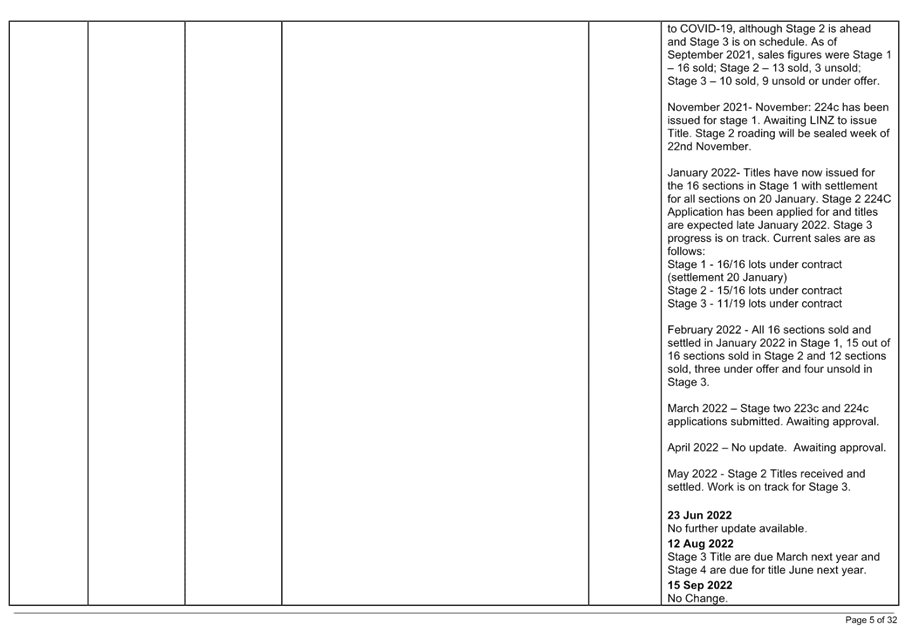

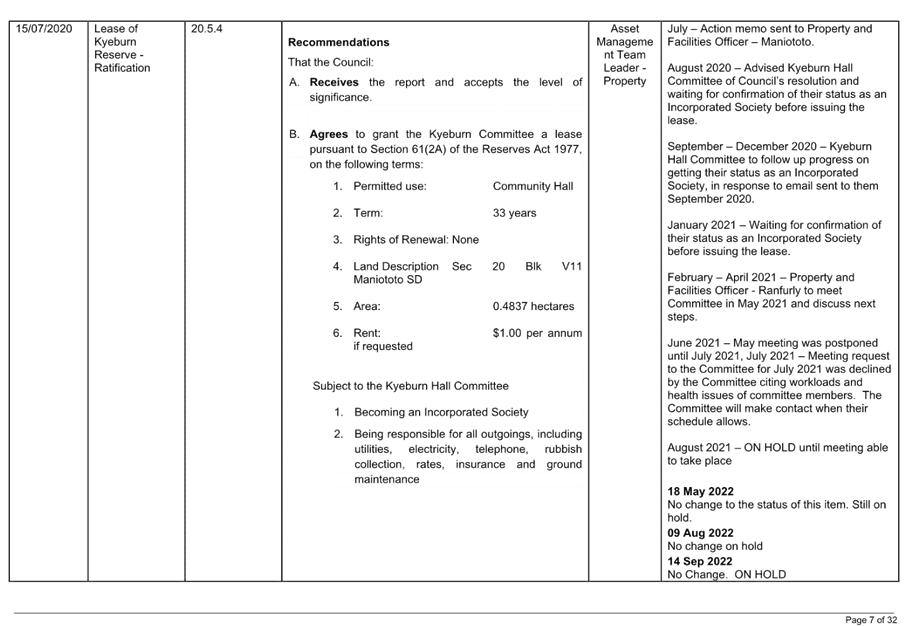



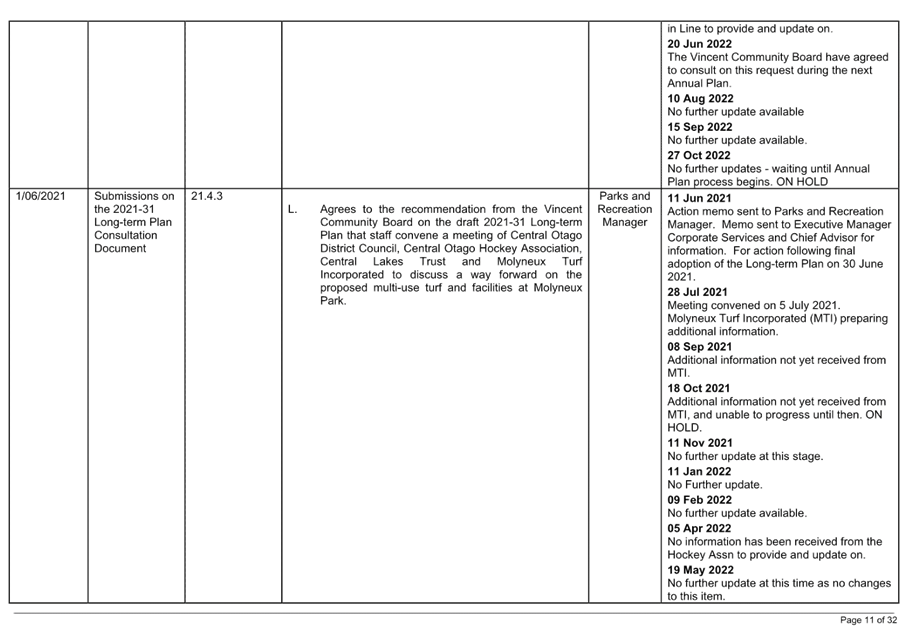
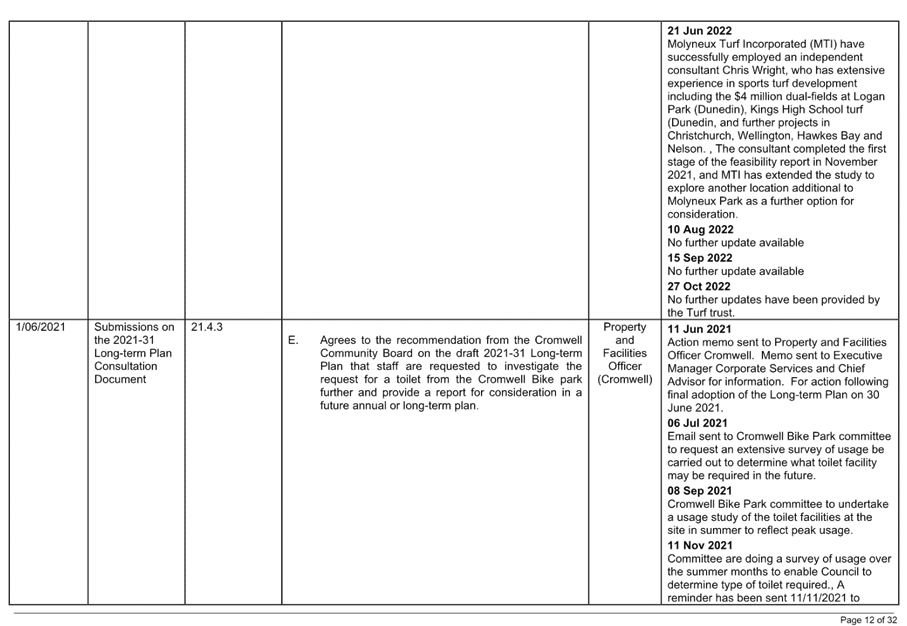

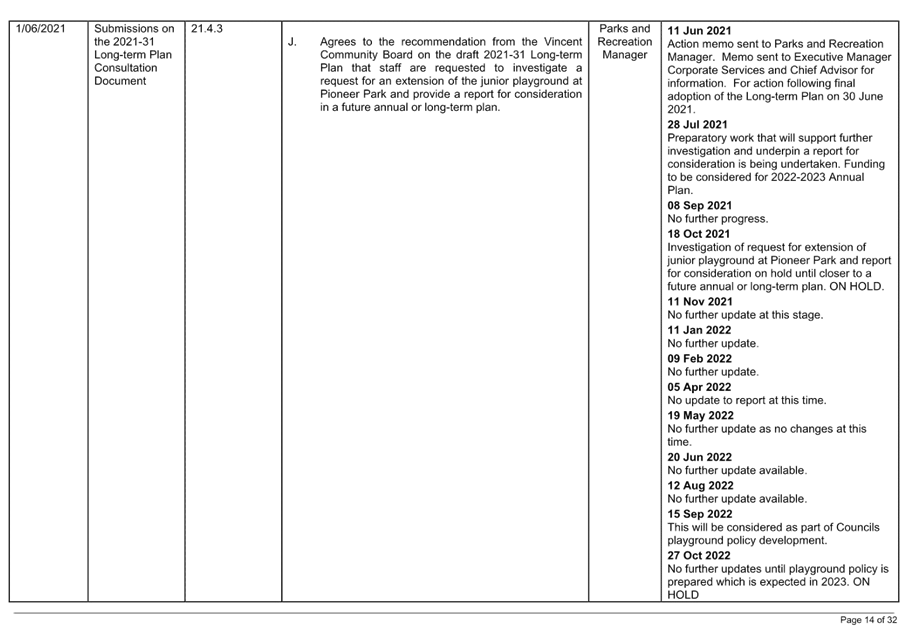
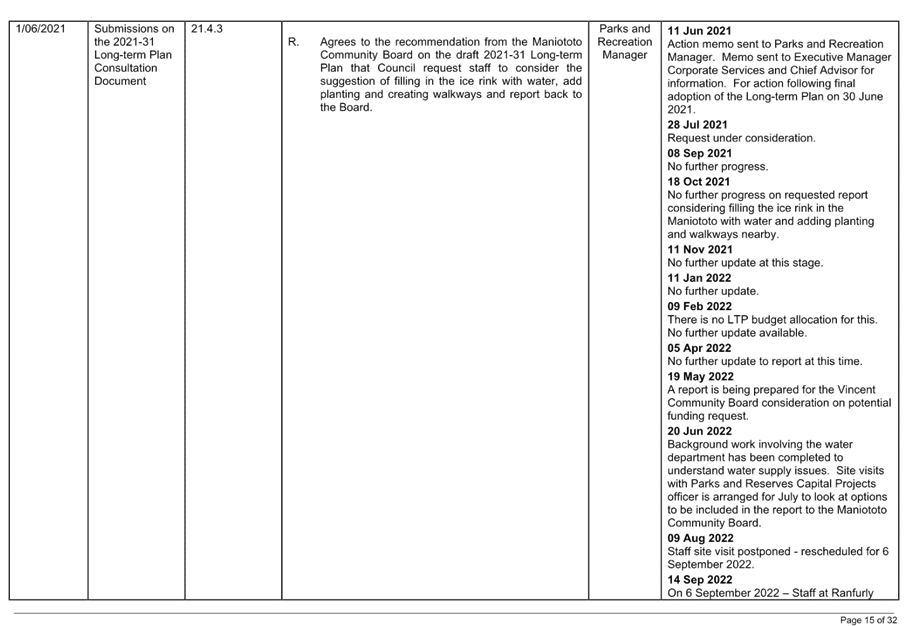
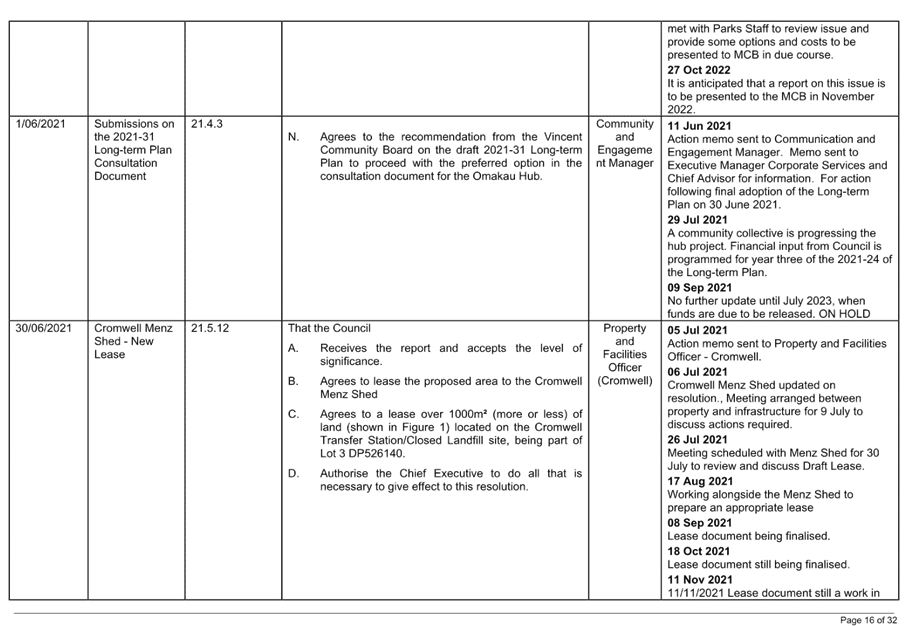
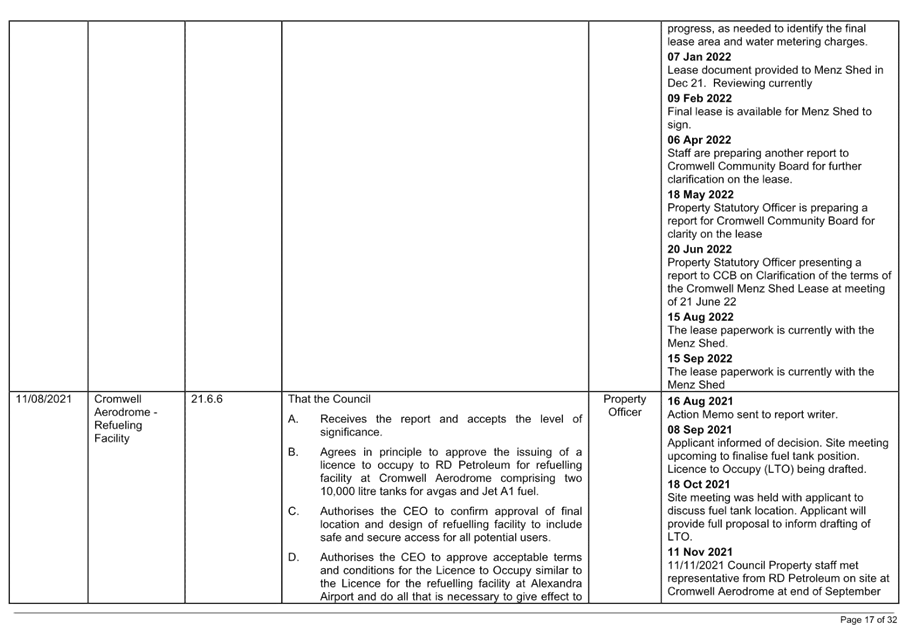

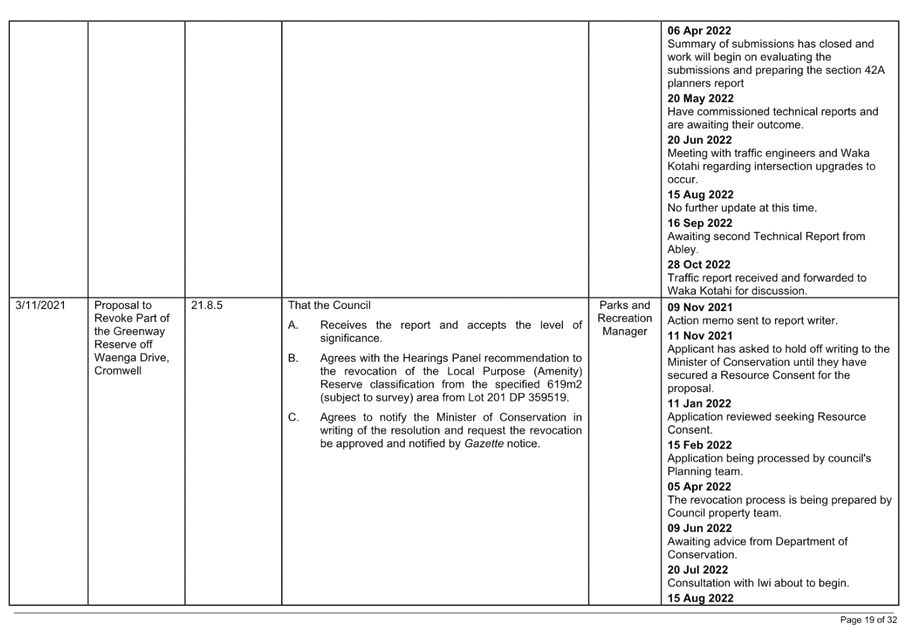


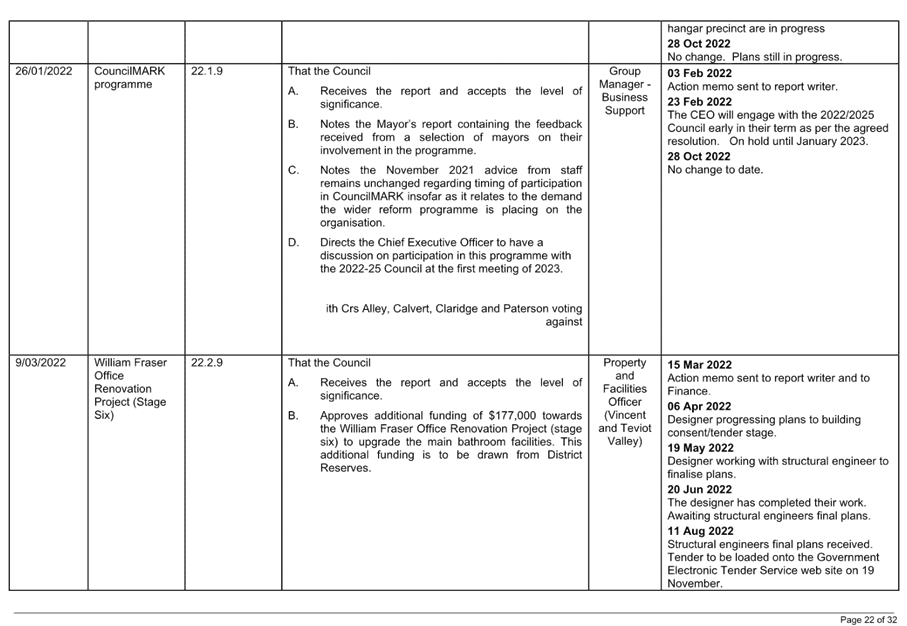
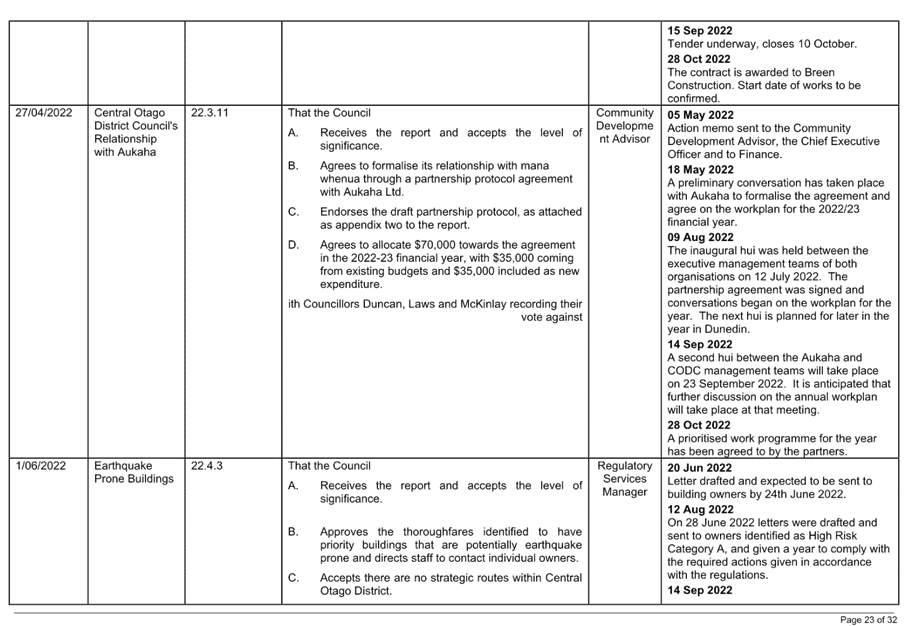
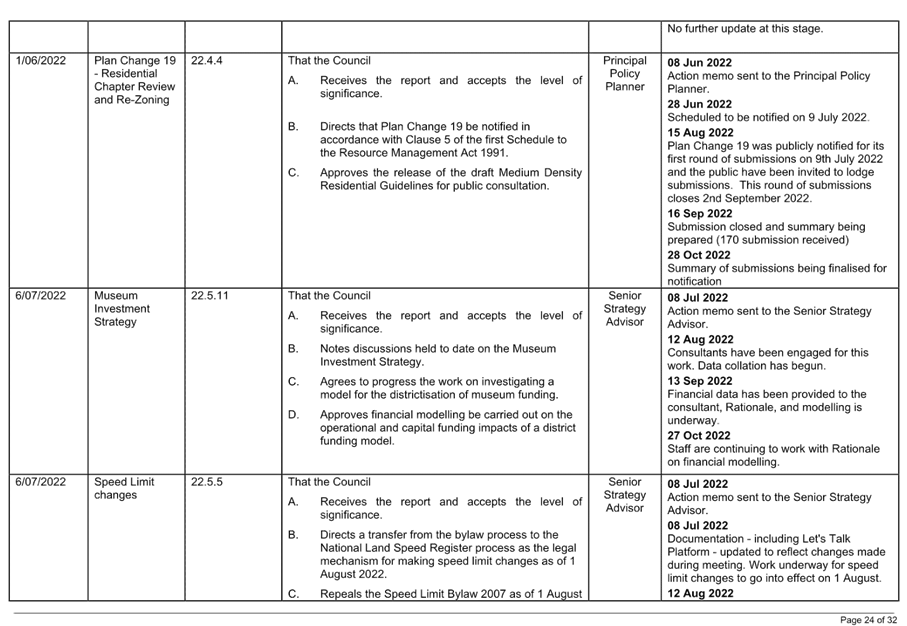
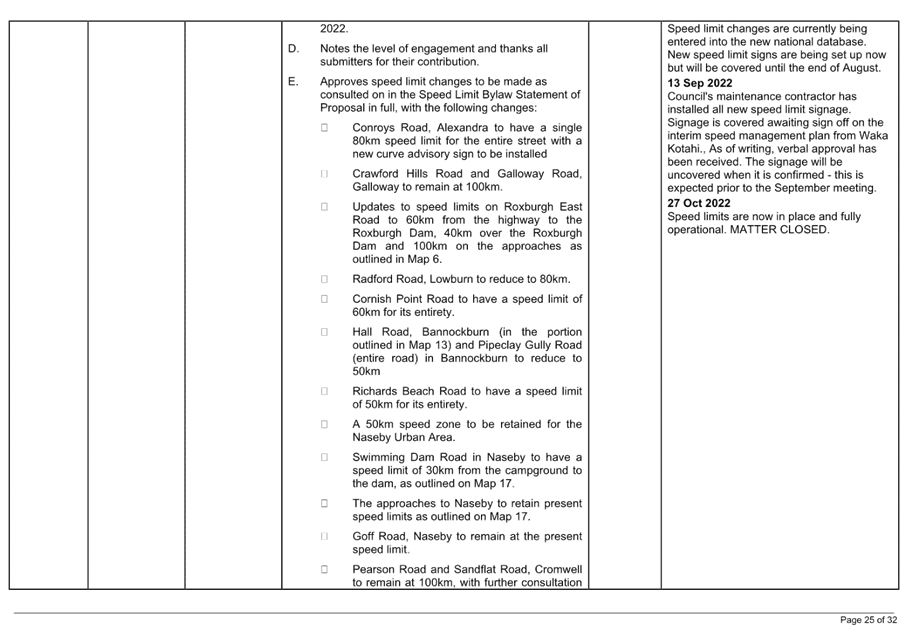
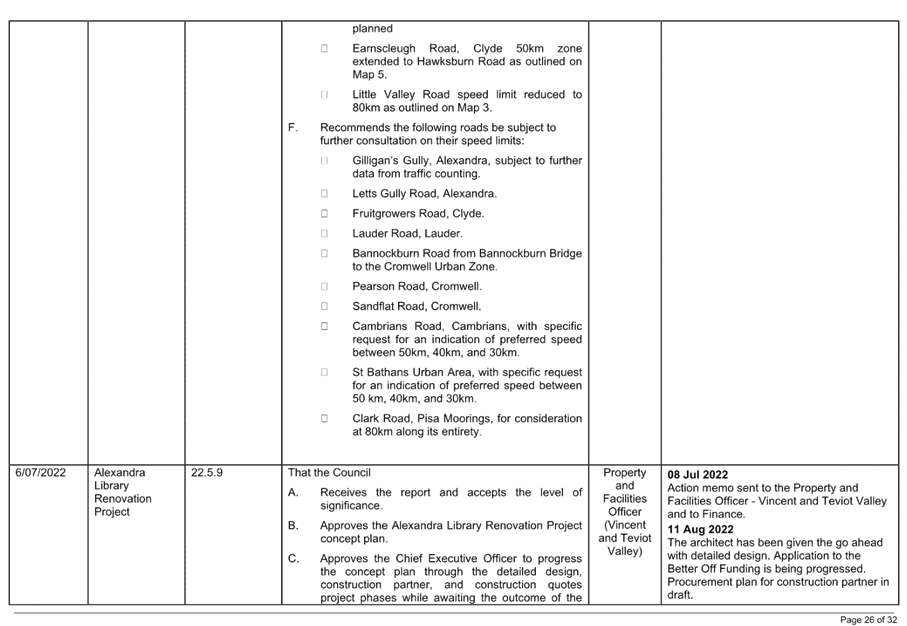
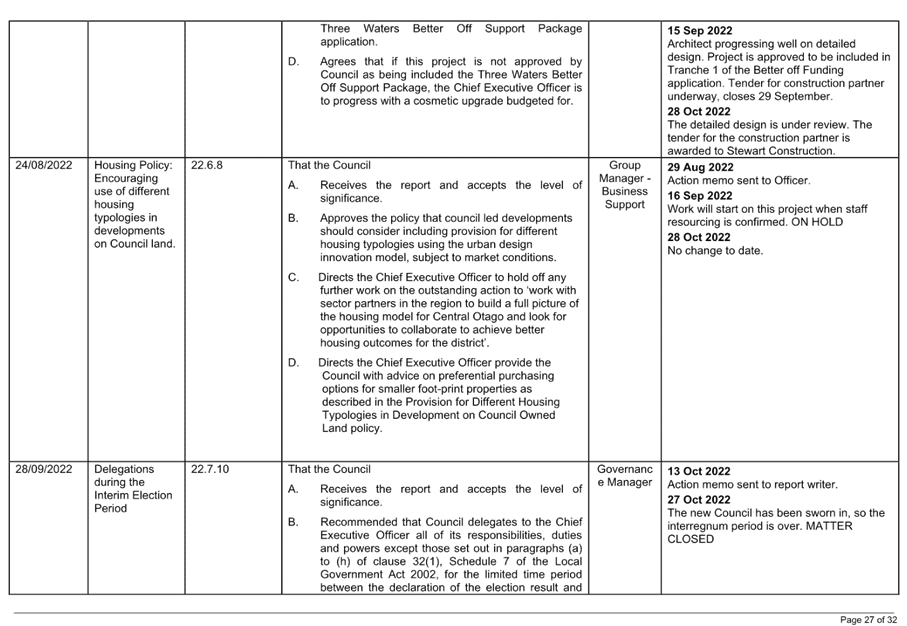
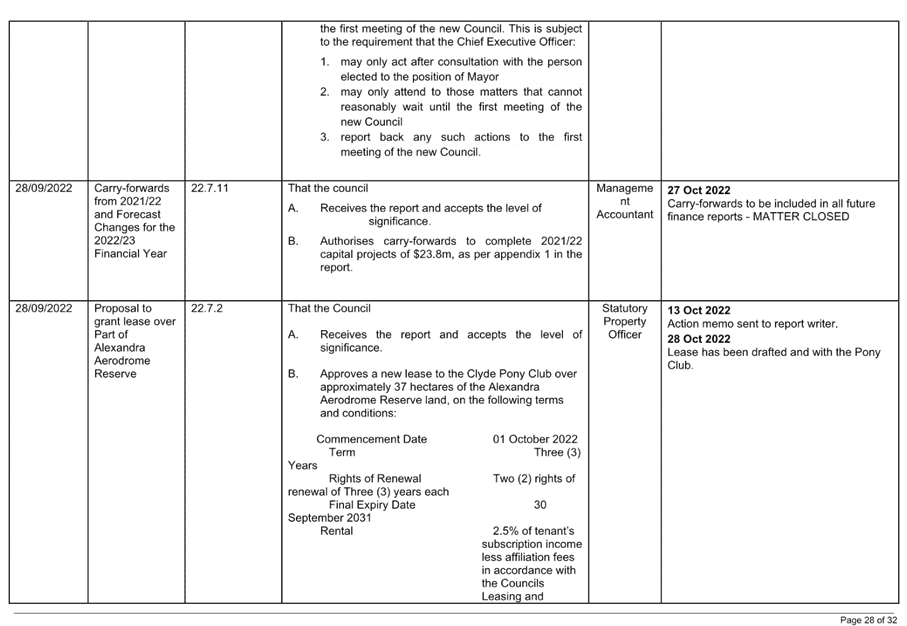
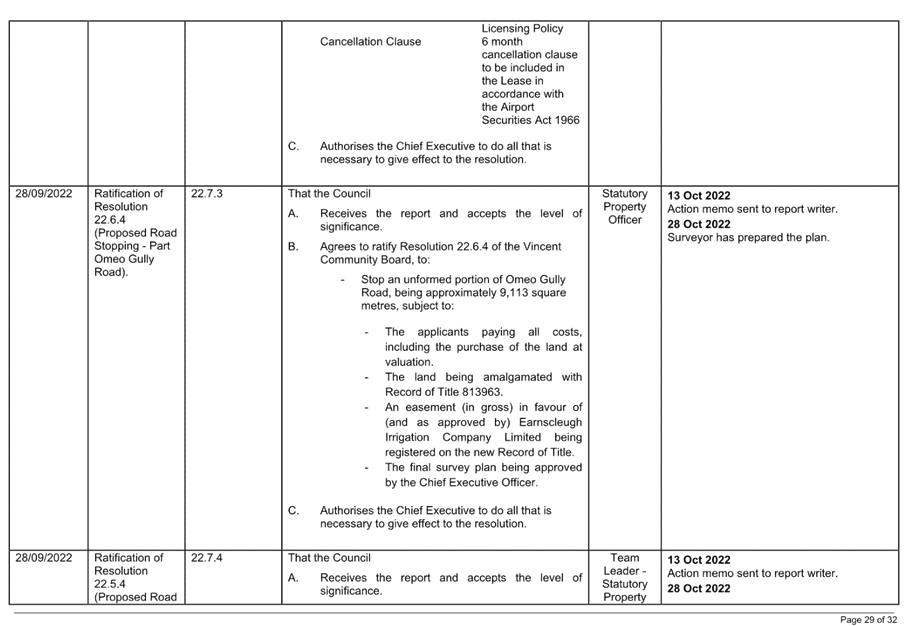
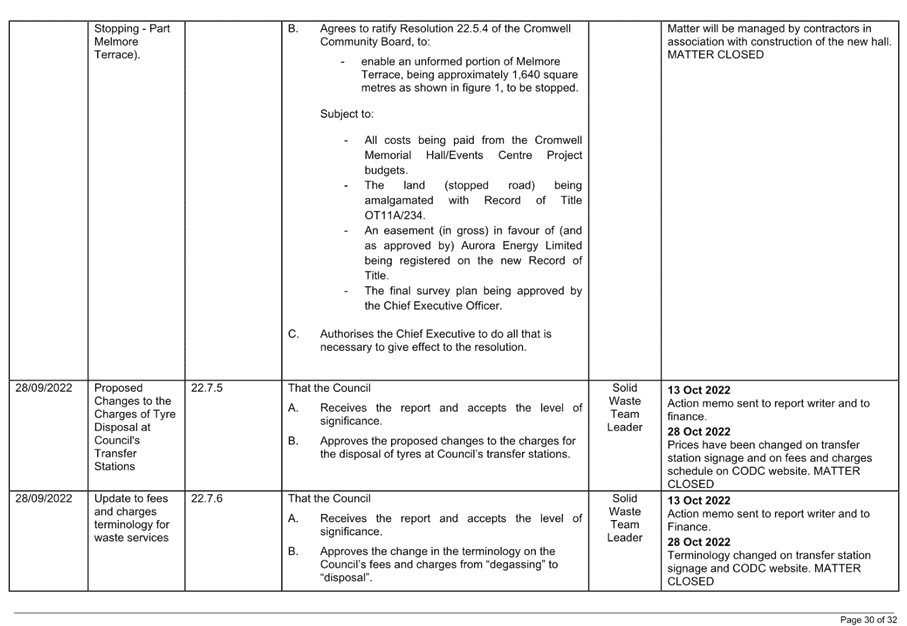
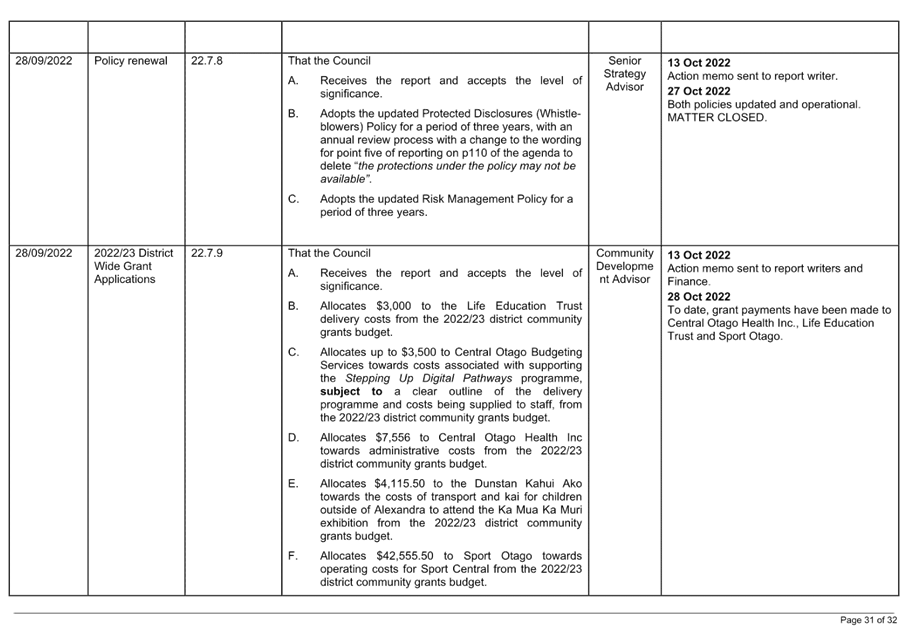

9 Resolution
to Exclude the Public
|
Recommendations
That the public be excluded from the following parts of
the proceedings of this meeting.
The general subject matter of each matter to be considered
while the public is excluded, the reason for passing this resolution in
relation to each matter, and the specific grounds under section 48 of the
Local Government Official Information and Meetings Act 1987 for the passing
of this resolution are as follows:
|
General subject of each matter to be
considered
|
Reason for passing this resolution in
relation to each matter
|
Ground(s) under section 48 for the
passing of this resolution
|
|
22.9.15 - November 2022 Confidential
Governance Report
|
s7(2)(i) - the withholding of the information is
necessary to enable Council to carry on, without prejudice or disadvantage,
negotiations (including commercial and industrial negotiations)
|
s48(1)(a)(i) - the public conduct of the relevant
part of the proceedings of the meeting would be likely to result in the
disclosure of information for which good reason for withholding would exist
under section 6 or section 7
|
|


































































































































































































































































































































































































































































































